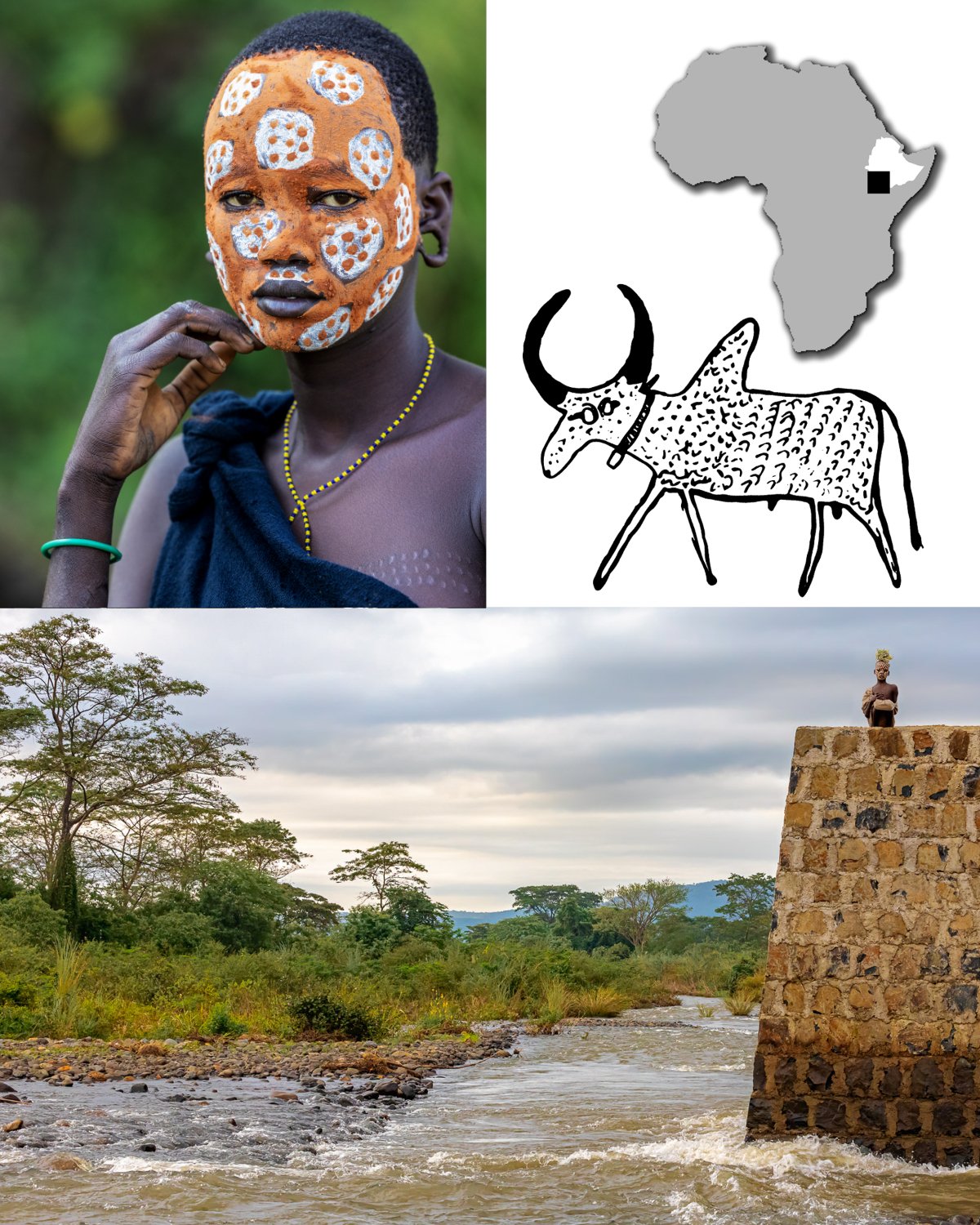
This collection presents the Suri, a small but resilient group in southwestern Ethiopia. You’ll meet my portrait collaborators, including Ngaturɛ, who painted her face using local natural pigments, continuing a long Suri tradition. The collection also includes word stories created by Suri members of the project that produced the first Suri literacy teaching tools, starting in the early 2000s when the written language was defined. These word stories provide fascinating glimpses of Suri culture. The drawing here is from one of those word stories.

The small Kibish River is a critical water source for nearby Suri. On the right bank at this point is a massive stone pier for a future bridge over the river. So far, there is no corresponding pier on the left bank and no comparably sized connecting road on either side of the river.
But this pier is a harbinger of coming development encroachment challenges for the Suri people in this area. Ngamɔri, the Suri youngster crouched on top of the pier, will likely experience those challenges in her lifetime. Kibish, Ethiopia, 2019.
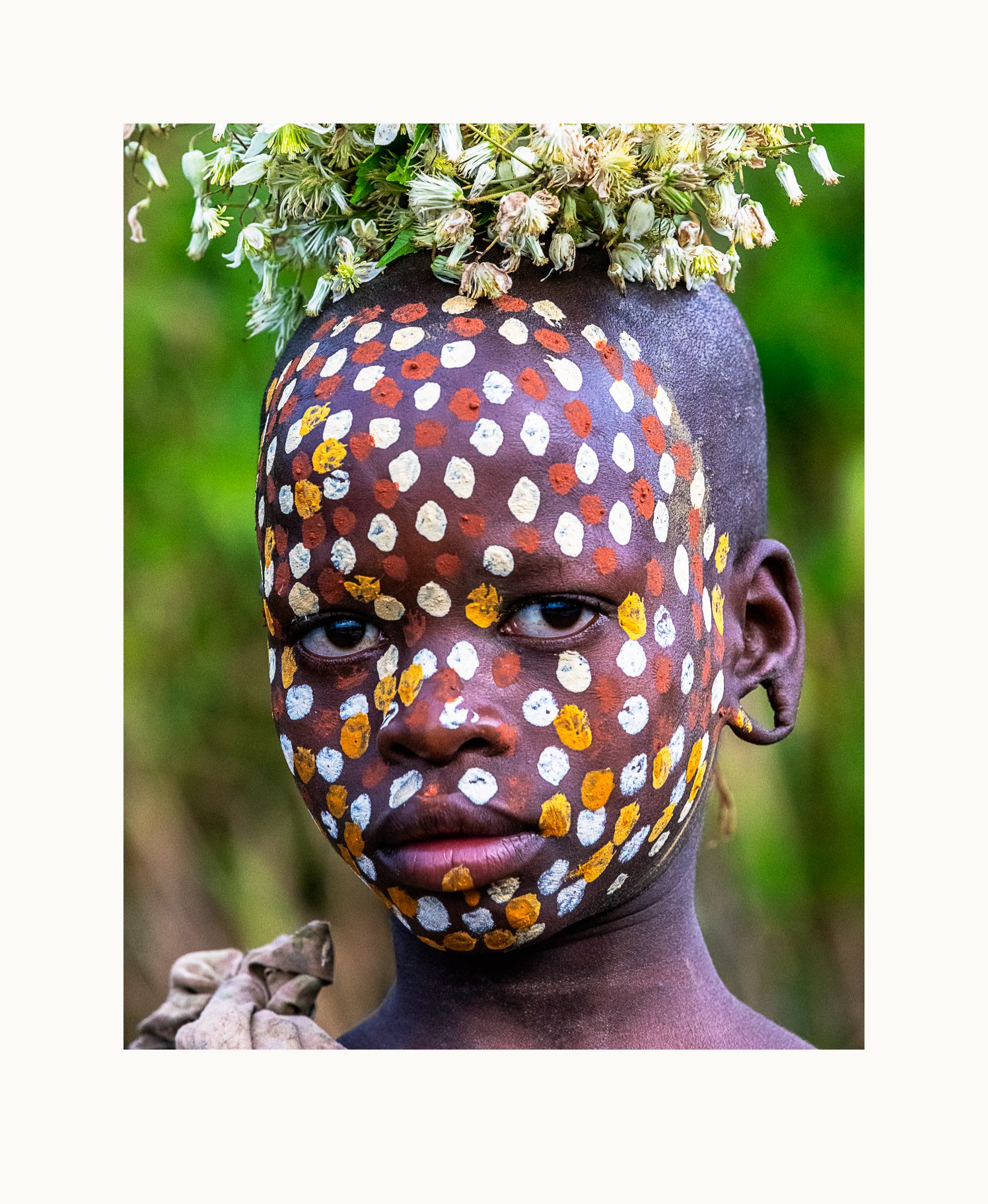
mɔri = pipe. Ngamɔri was born when her mother went to fetch water at a break in the pipeline carrying water to her village.
Suri parents encourage their children, both boys and girls, to be independent and assertive. Parents don’t use physical punishments, like beatings, but instead emphasize verbal encouragements and reprimands. Kibish, Ethiopia, 2019.
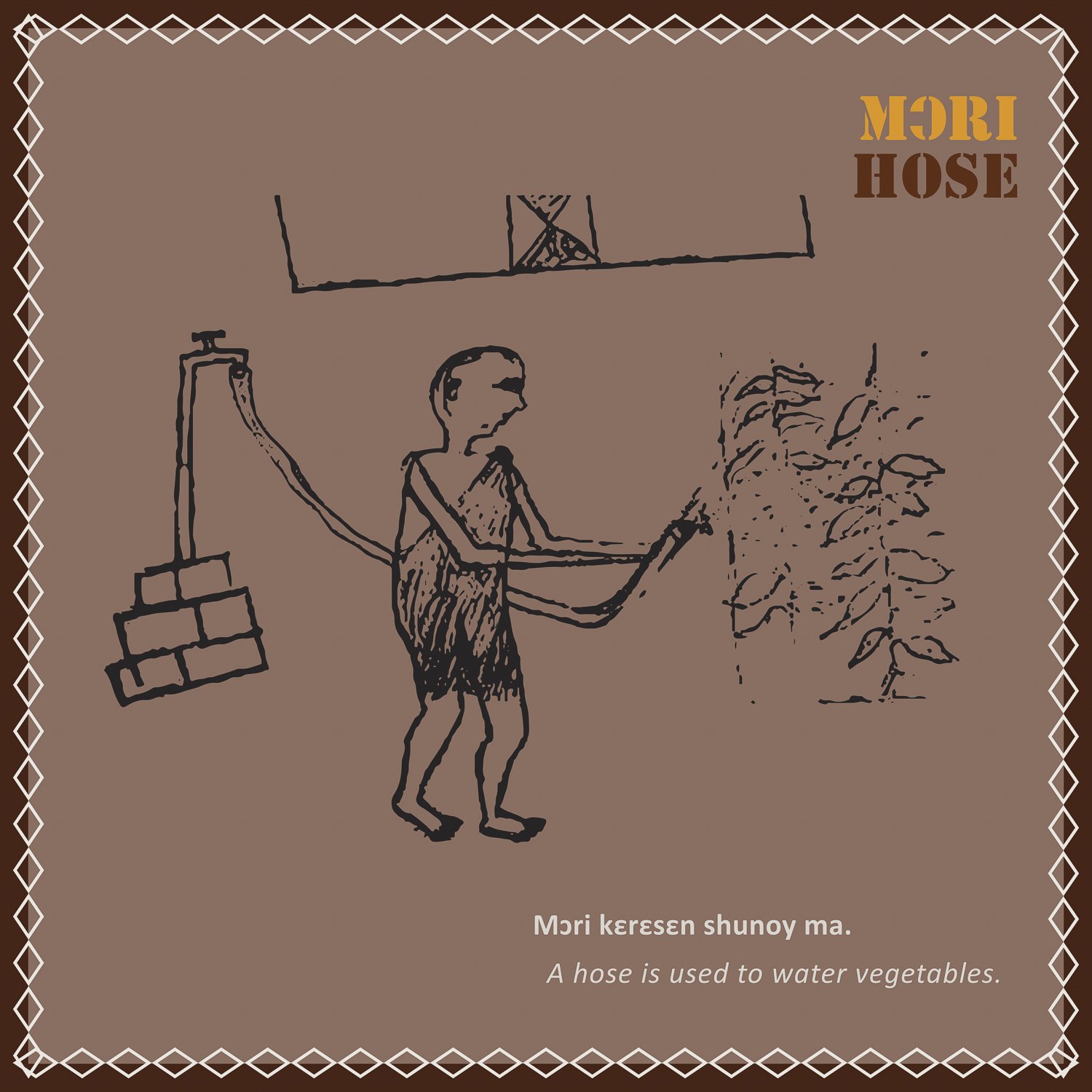
One meaning of mɔri is hose. Some larger Suri villages with a nearby perennial water source, such as Kibish, have water delivered via pipeline, then distributed within the village for domestic and garden use.
Suri author/artist: Gergere Siralugu

The word mɔri can also refer to tubular musical instruments, such as the flutes and horns referenced in this word story.
Suri author/artists: Damini Gelu, Ngaidho Bebhala

kɛdhɛdhi = wood ant. Wood ants are tiny and Ngakɛdhɛdhi was a tiny baby.
In addition to face paint and decorated earlobe discs, Ngakɛdhɛdhi has adorned her head with the long-haired fur of a colobus monkey. Colobus monkey fur is a traditionally respected form of head dress for Suri. Kibish, Ethiopia, 2019.
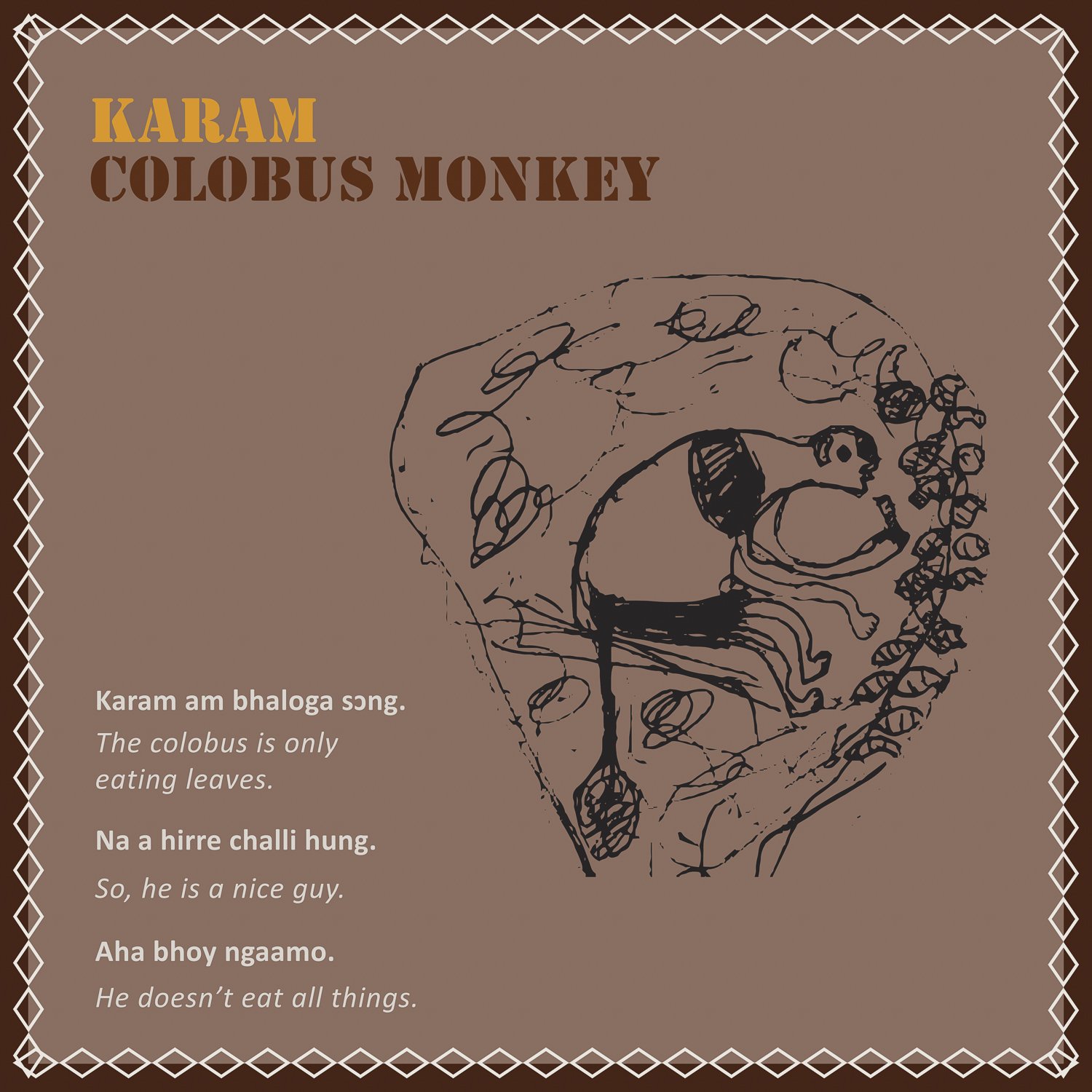
Colobus monkeys are popular with the Suri; they’re easy to live with.
Suri author/artist: Barkoginɛ Olrɛghɛ
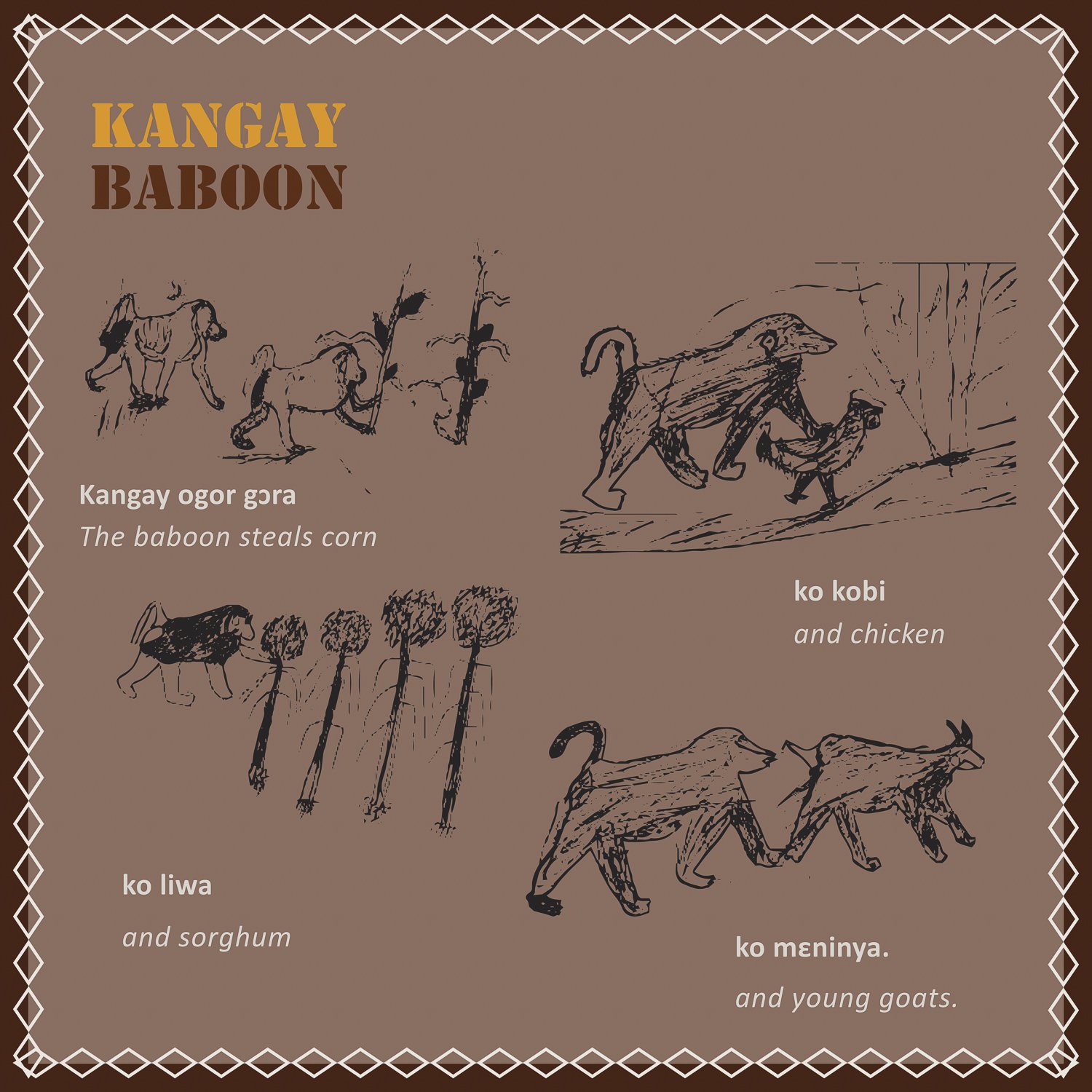
Baboons, on the other hand, are a hassle to live with; they’re always stealing.
Suri author/artists: Gergere Siralugu, Bargoy Dhɔgani, Barlɛng Konggulugu, Barlolu Olechagi
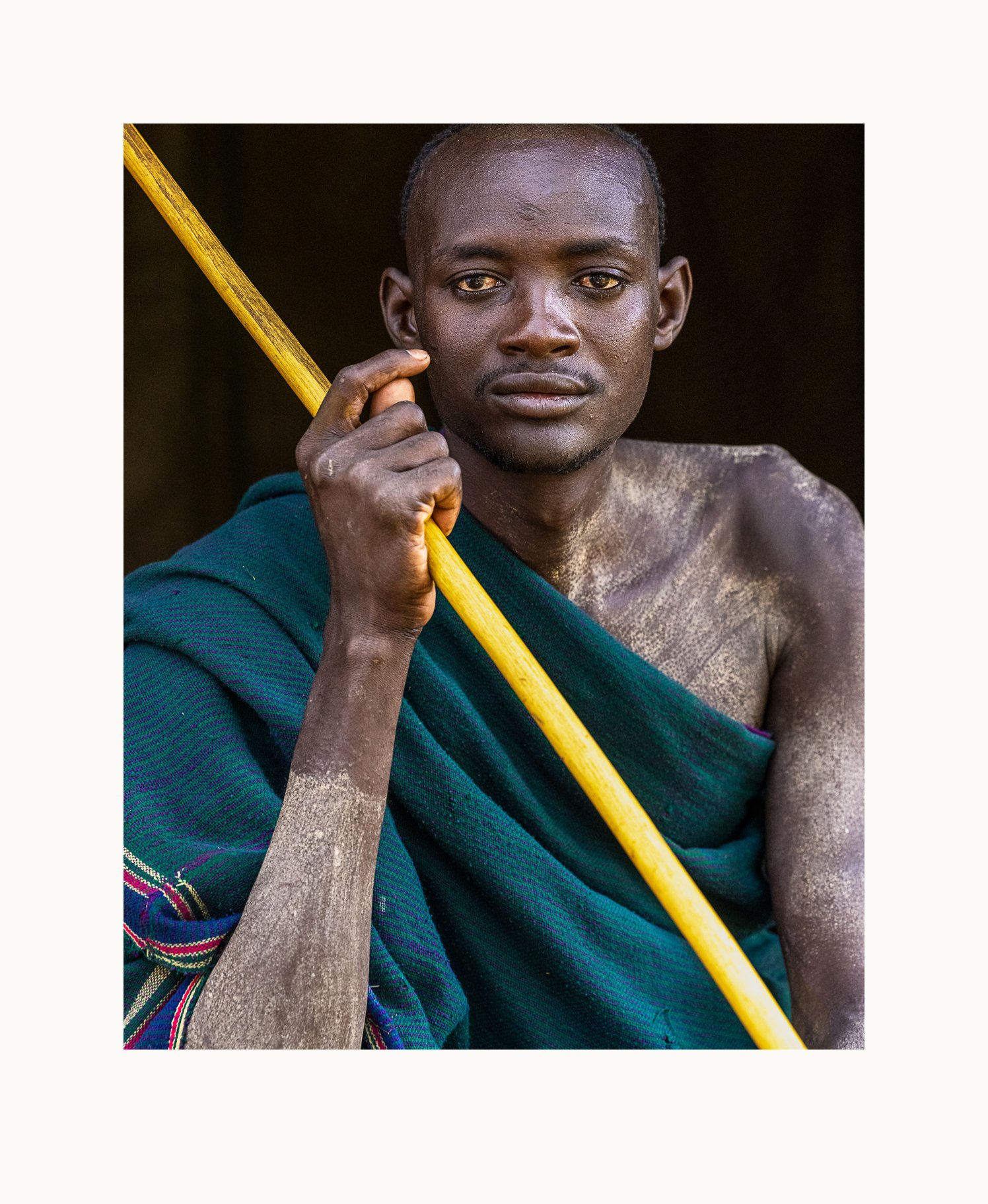
konen = related by marriage, brother-in-law, for example.
Barkonen also participated in the previous day’s saginɛ (ceremonial stick fight), using his prized dongga (wooden staff). Consistent with tradition, he painted his body with clay for the event.
He started doing saginɛ when he was 12 years old. For every saginɛ, he gives necklaces to his girlfriend. It is important that she wears them at the saginɛ to show that they’re still a couple.
Barkonen is not yet married; he’s still collecting the necessary cattle. The Suri bridewealth tradition requires that his family transfer several dozen cattle before a marriage can happen. Kibish, Ethiopia, 2021.

mugur = darkness; hallo = hello on the phone.
Suri young people who paint their bodies sometimes choose matched patterns to celebrate a friendship. Each Suri boy receives a favorite young bull and he is responsible for its care. He is often addressed by the name of the bull and invokes that name in battles and on ritual occasions. Kibish, Ethiopia, 2019.
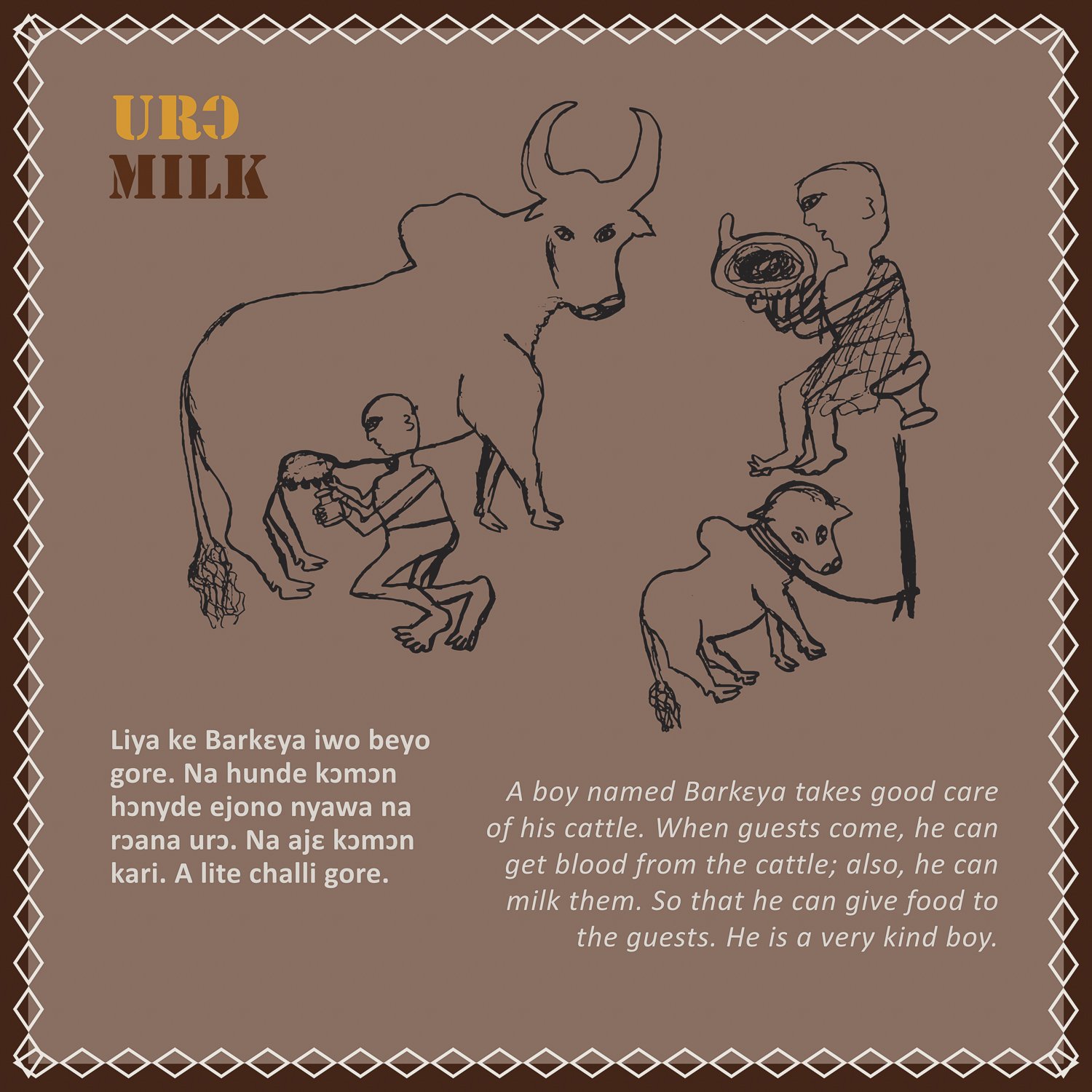
Suri boys often have cattle-related responsibilities, as illustrated in this word story.
Suri author/artist: Gergere Siralugu

turɛ = a special category of horn, including that used in the kilonga, a ceremony honoring a family-chosen anniversary of a passed elder. The kilonga ceremony is an important occasion at which family and friends in the passed elder’s community bring their favorite bulls and pay their respects. Ngaturɛ was born during a kilonga ceremony.
The role that cattle play in the consequential kilonga ceremony is further confirmation of how integral cattle are to Suri life. By tradition, Suri babies born during a kilonga are often named Ngaturɛ (for girls) or Barturɛ (for boys). Kibish, Ethiopia, 2021.

turɛ = a special category of horn that includes a type used in the kilonga ceremony that honors a family-chosen anniversary of a passed elder. Family and friends in the passed elder’s community bring their favorite bulls (usually adorned) and pay their respects.
Barturɛ was born during a kilonga ceremony. He is not married. He had a girlfriend, but her family asked for more cattle as bride-wealth than he could manage. Kibish, Ethiopia, 2021.
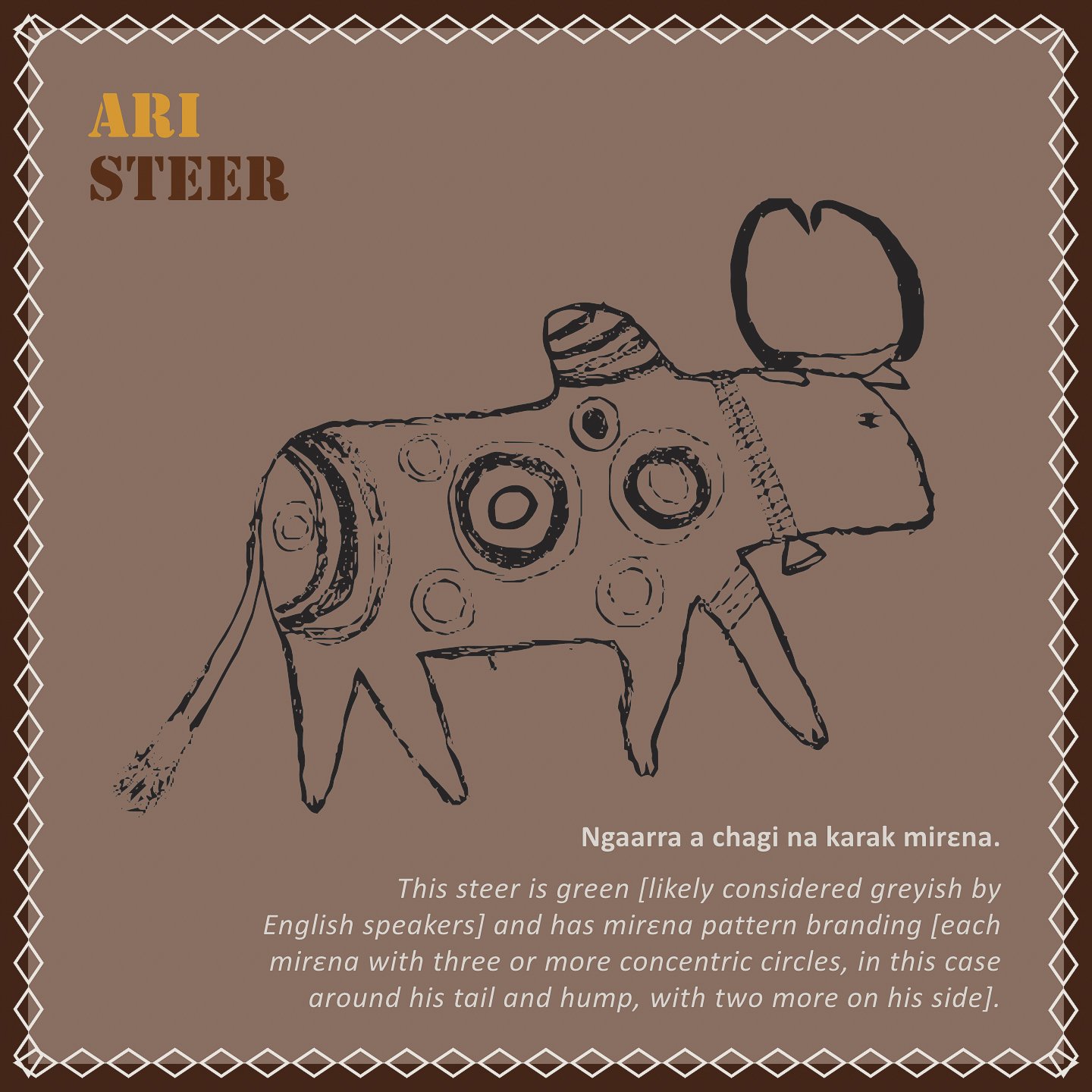
The owner of this steer has done elaborate adornments to demonstrate his affection. Most of the cattle brought to a kilonga ceremony would be extensively adorned, as well.
Suri author/artist: Barlolu Olechagi

lulɛ = a coordinated pattern, such as stripes on a zebra.
Ngalulɛ is a guest at a Suri wedding. For the Suri, a marriage is a multi-faceted alliance between the families of the bride and groom, culminating a lengthy negotiation between the two families, initiated by the prospective bride. The new bride will occupy her own hut, establish a separate domestic unit for herself and her children. A Suri husband spreads his time among the family units of his wives. Kibish, Ethiopia, 2019.

Ngalulɛ’s portrait was made at a Suri wedding. As usual for married Suri women attending a wedding, she wore her gal for the event.
Suri author/artist: Gergere Siralugu
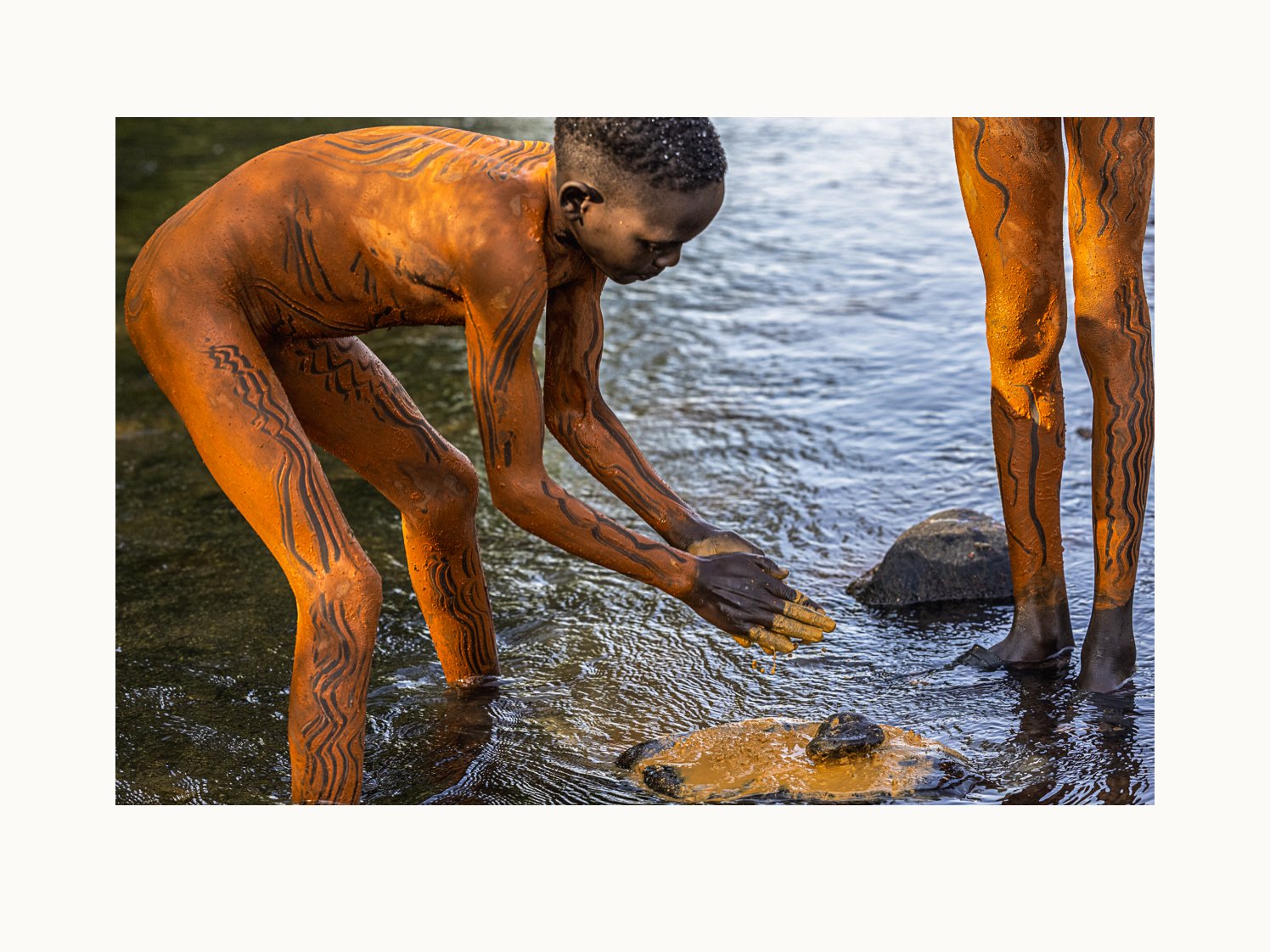
Barhallo, already painted, is preparing to add paint to the face of Barsu, standing in the shallow Kibish River to his right.
Pigments are brought to the river as soft rock or clay: a specific type for each desired color. At the river, pigment material is crushed and mixed with water, then applied. Kibish, Ethiopia, 2021.
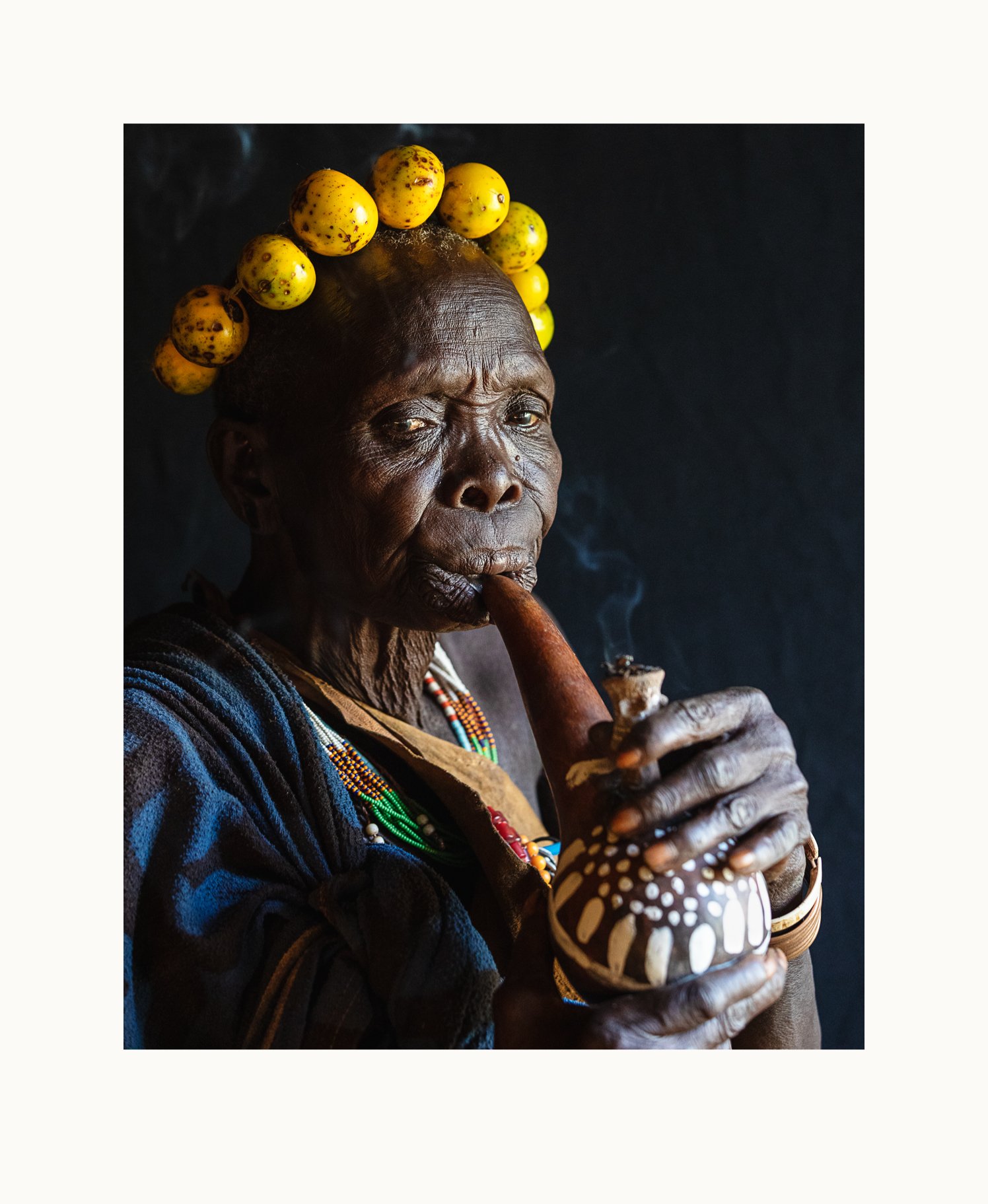
sedhey = girl; there were many young girls in the village when Ngasedhey was born.
When asked her age in 2021, she jokingly replied “200 years!”. Like Ngalulɛ, another elder Suri woman, Nga-sedhey had comments on non-traditional aspects of some of the adornments in my 2019 portraits. She expressed particular concern about the woven wreath that Ngakɔshi was holding in front of her face.
During our 2023 visit to Kibish, we had a smaller version of the 2nd generation exhibit hung among some trees in our camp. One of the Suri visitors to the exhibit was a daughter of Ngasedhey, who conveyed the sad news that her mother had recently passed away. The daughter was strongly moved by her mother’s portrait. Kibish, Ethiopia, 2019.
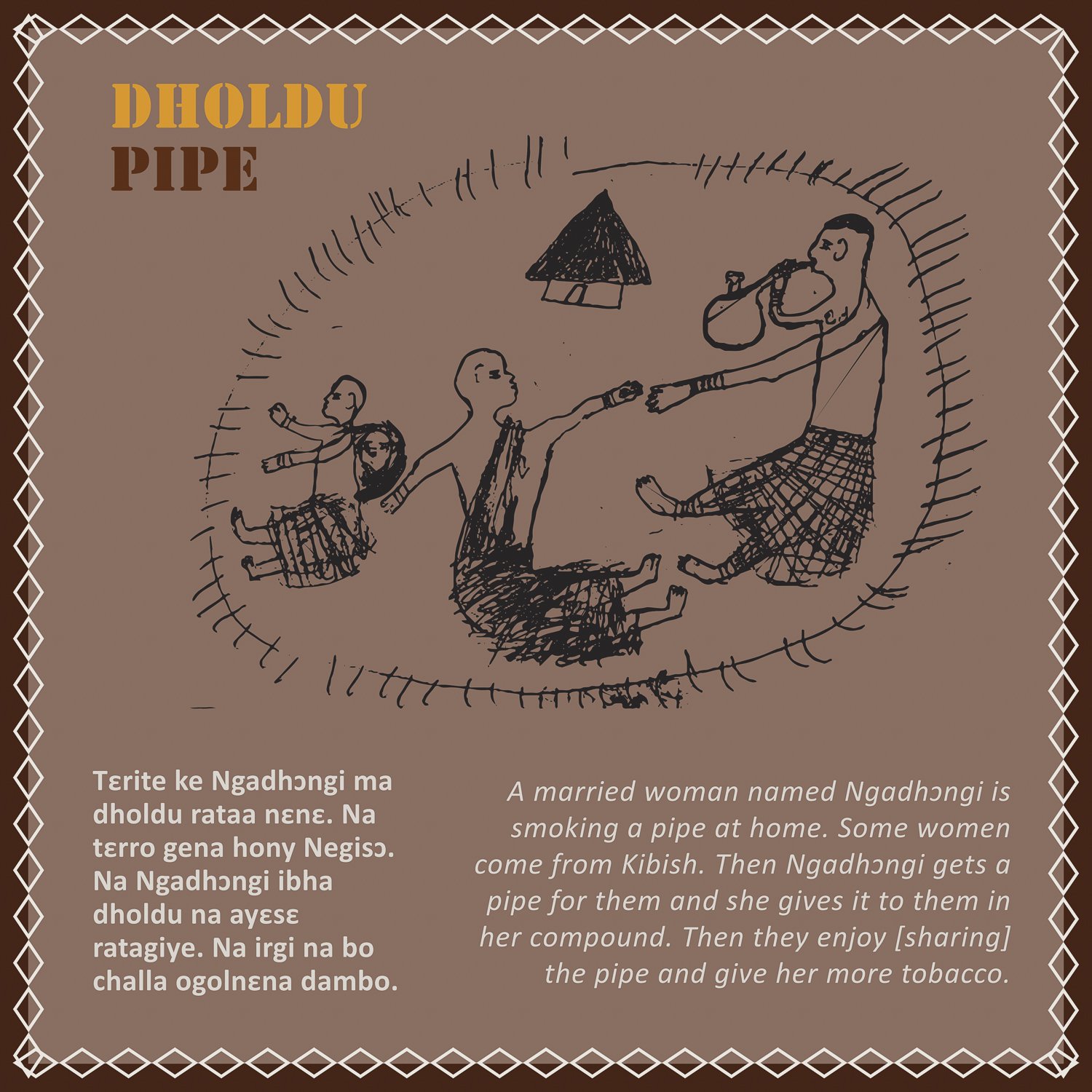
Smoking pipes made locally from garden-grown gourds (often decorated) can be an enjoyable communal activity.
Suri author/artist: Barlɛng Konggulugu
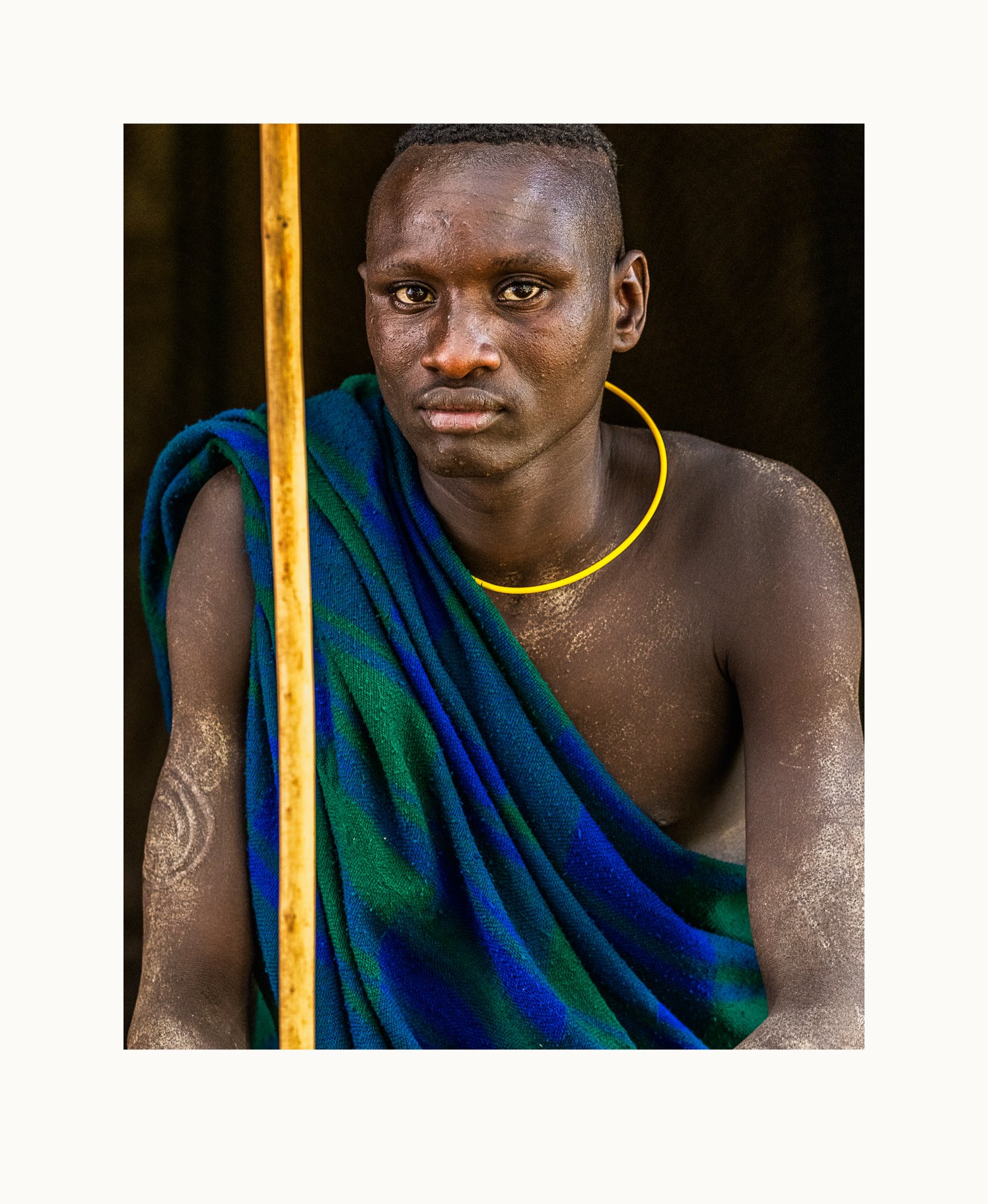
burbur = helicopter.
Burbur’s dongga (wooden staff) is the crucial weapon in a saginɛ (ceremonial stickfight). Saginɛ is very important to him. He’s a good fighter and has over 50 saginɛ wounds.
A Suri young man’s dongga is a multi-purpose tool, useful in cattle herding, for instance, but also as a personal statement, for example to impress a girlfriend.
Like many saginɛ participants, Burbur painted his body with clay for the prior day’s event. Kibish, Ethiopia, 2021.

baku = open air. Suri spend most of their waking hours in open air.
Ngabaku participated in courses taught in Suri and found them helpful, “because they were taught in my own language.” Also, there were incentives to take Suri classes, such as pen and pencil, exercise books; those were valuable, also.
When asked how she feels about being Suri; Ngabaku said: “Being Suri is happiness and delight!” Kibish, Ethiopia, 2019.
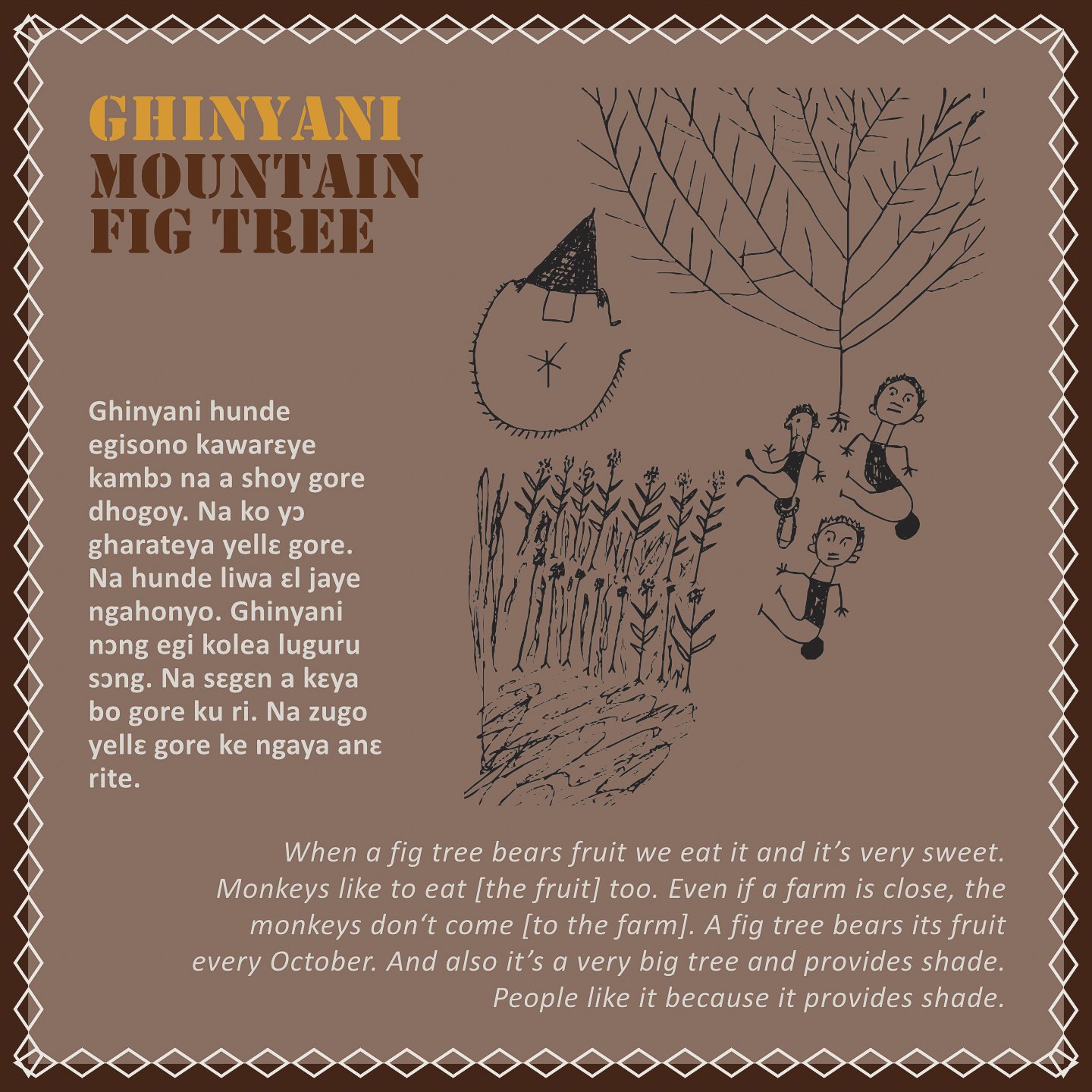
Mountain fig trees provide numerous benefits to the Suri, including those summarized in this illustrated story.
Suri author/artist: Bargoy Dhɔgani
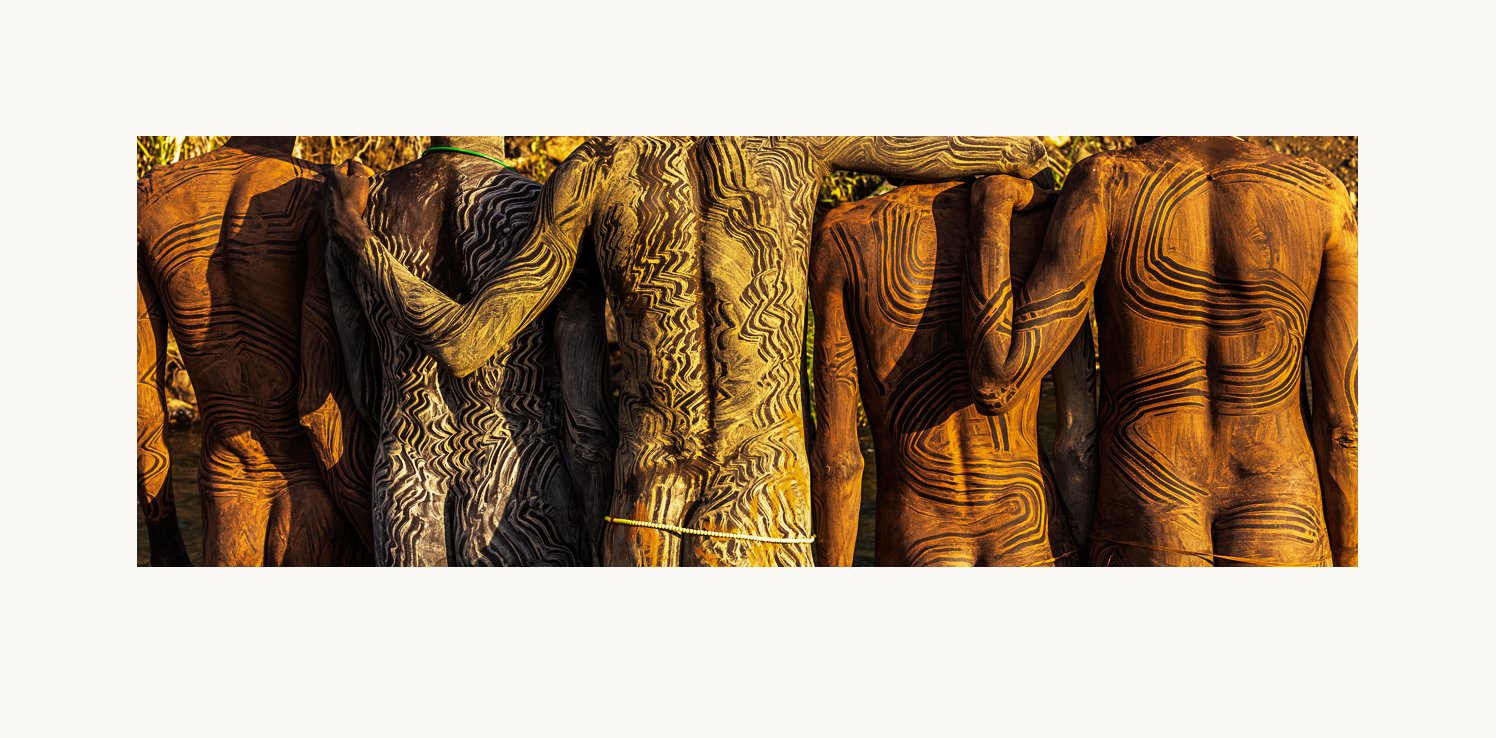
For Suri men and boys, the painting tradition is a whole-body one.
A group of young men has just finished a body painting session at the Kibish River. They share their results in golden hour sunlight. Many of them would join the next day in a saginɛ (ceremonial stick fight), where most participants have painted bodies.
These Suri young men are in the tegay age set.
Body painting for Suri young men can be health- or hygiene-motivated, also. For instance, someone who is away from water in a remote camp and unable to bathe may cover his body with clay and then rub it off with a corn cob to clean. Kibish, Ethiopia, 2021.

Suri young men in the tegay age set have just completed a session of body painting at the Kibish River. They pause on the bank with the verdant landscape and distant mountains of Suri country in the background. Kibish, Ethiopia, 2021.
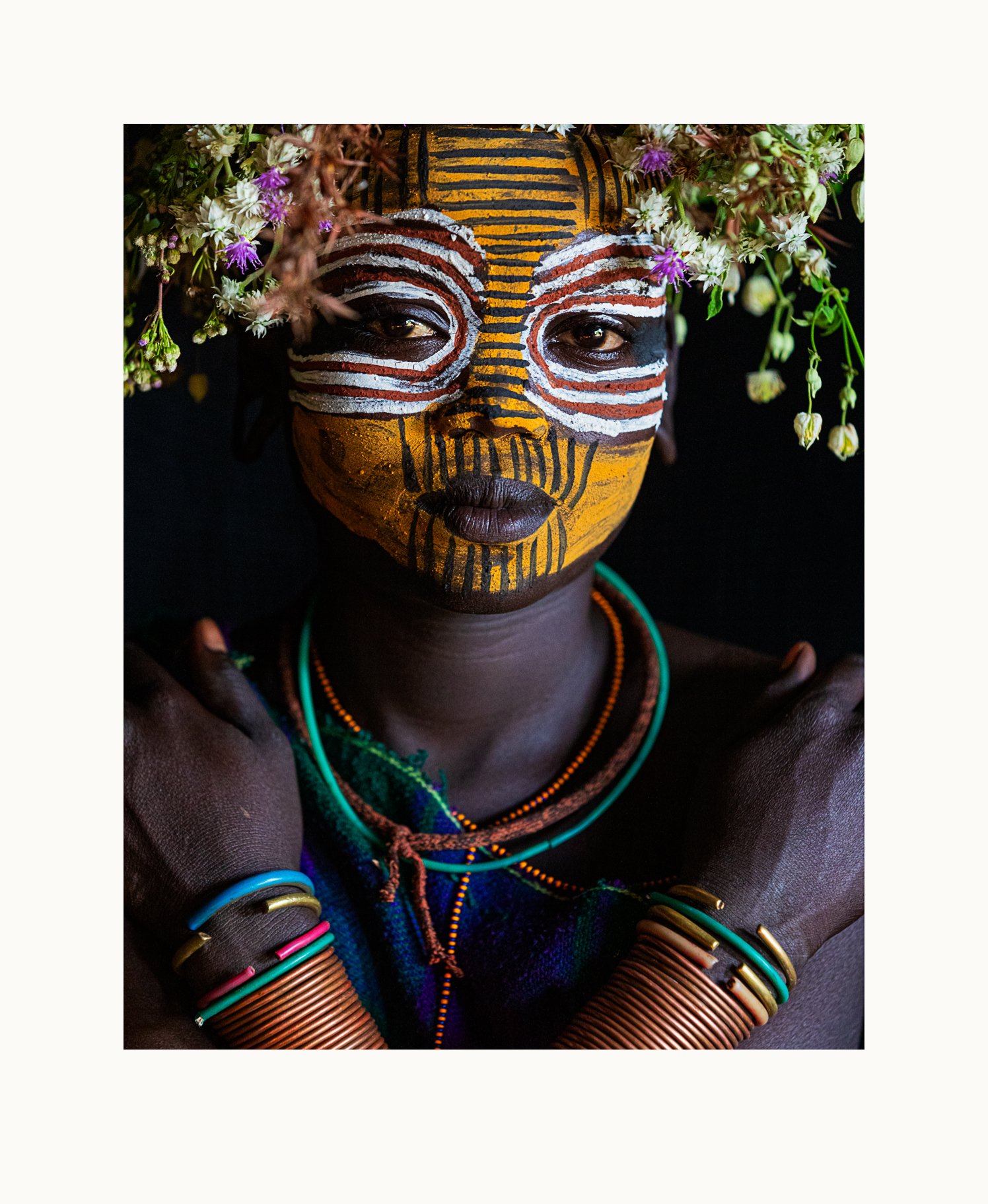
gu = garden. Ngagu was born in the garden behind her family hut.
Suri women maintain small gardens next to their family hut, where they grow vegetables, as well as gourds for use as containers.
Ngagu has taken courses in Suri and believes they helped her to learn more effectively. Kibish, Ethiopia, 2019.
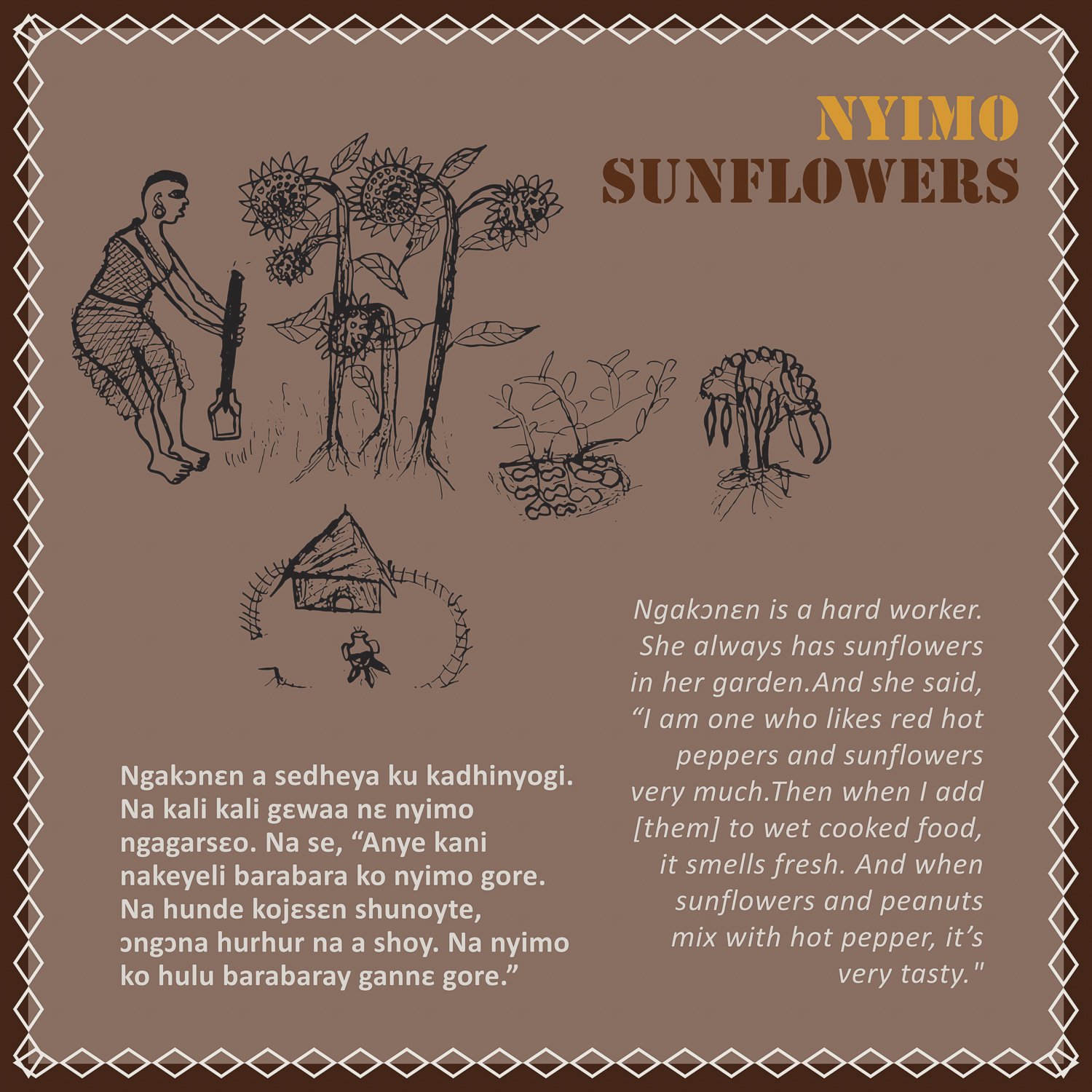
Here we learn some vegetable recipe preferences of a woman named Ngakonɛn.
Suri author/artist: Gergere Siralugu

dukuwa = umbrella. However, in Ngadukuwa’s case, the important meaning of the word is a cattle color: a particular shade of white.
Ngadukuwa received her name when she got married, to honor both her and her husband. Dukuwa is both the name and the color of her husband’s favorite bull.
She wears her lip plate for special occasions like weddings and when serving her husband food and drink, because it shows respect. However, she has some regret that she adopted the lip plate tradition as a young girl, because the current generation doesn’t do lip plates. Kibish, Ethiopia, 2019.
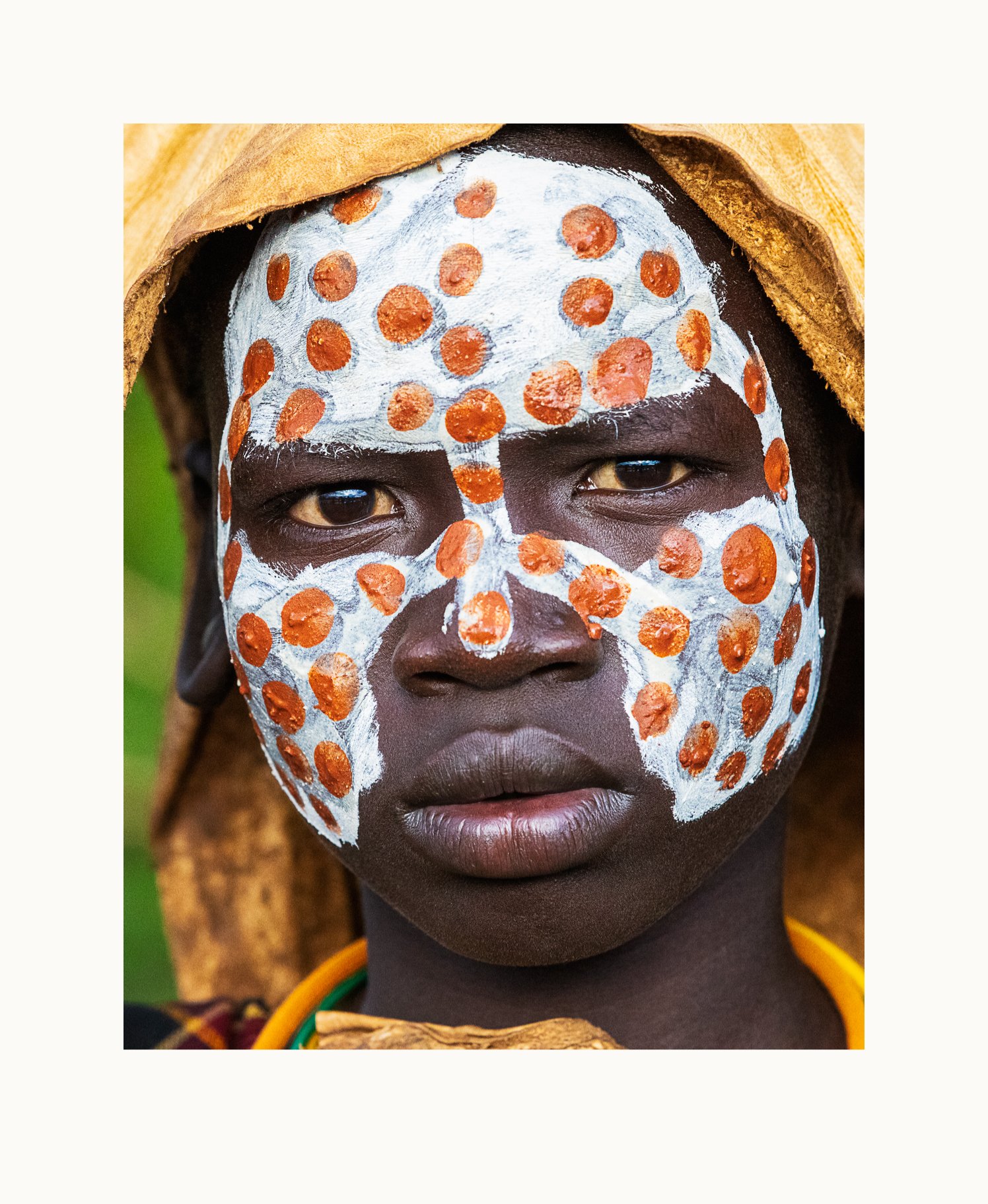
biri = Ethiopian unit of currency, the birr.
In my 2021 exhibit and book, I identified Ngabiri as a man named Ngachurta, noting that it’s unusual for a man’s name to have the “Nga” prefix.
This mis-identification started when I didn’t get names for my Suri portrait collaborators as I was making the portraits in 2019. I had to scramble (during the pandemic in 2020!) to get their names long distance. Our lead Ethiopian guide helped by transferring thumbnail images to the local Suri guide, who showed them on his phone to ask for names. This awkward process mostly worked, but not always. Lesson: if you care about collaborator names (and you should!) learn them at portrait creation! Kibish, Ethiopia. 2019.
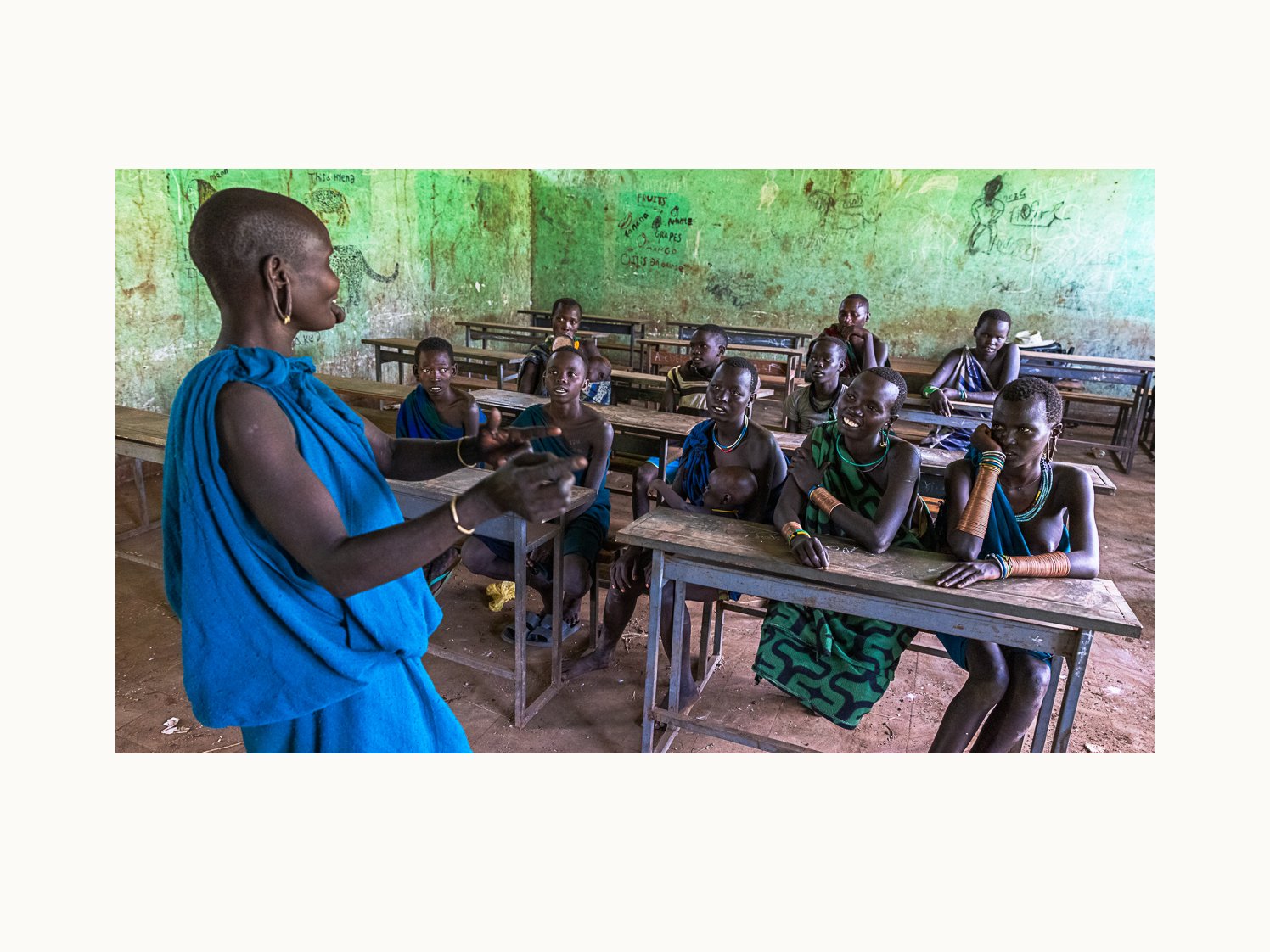
Ngaidho works informally with students in government school classroom. She taught for 10 years with the Suri Literacy Project (SLP), mostly with adult women students.
After almost two years of closed schools, teachers and students were enthusiastic about reconnecting in a classroom setting.
The SLP ended in mid-2021, leaving Ngaidho unemployed and her adult students with worries and questions about their and their families’ educational futures. Kibish, Ethiopia, 2021.
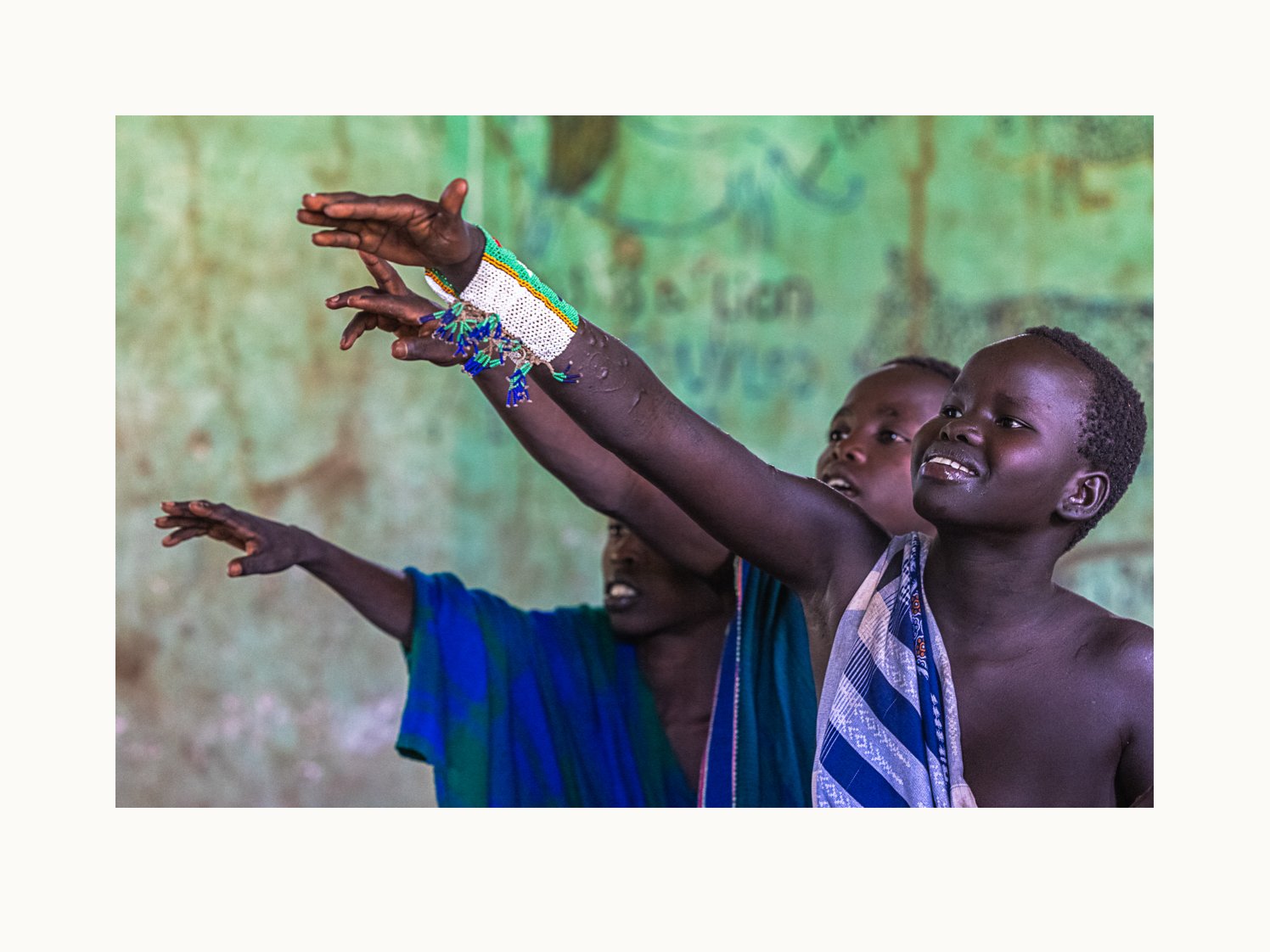
When we interviewed her, Ngaguyɔ (in the foreground, clearly an enthusiastic student) told us that she aims to become a doctor.
She also said that she enjoyed participating in Suri literacy classes. She found it helpful to learn in Suri because it is her mother tongue. Kibish, Ethiopia, 2021.
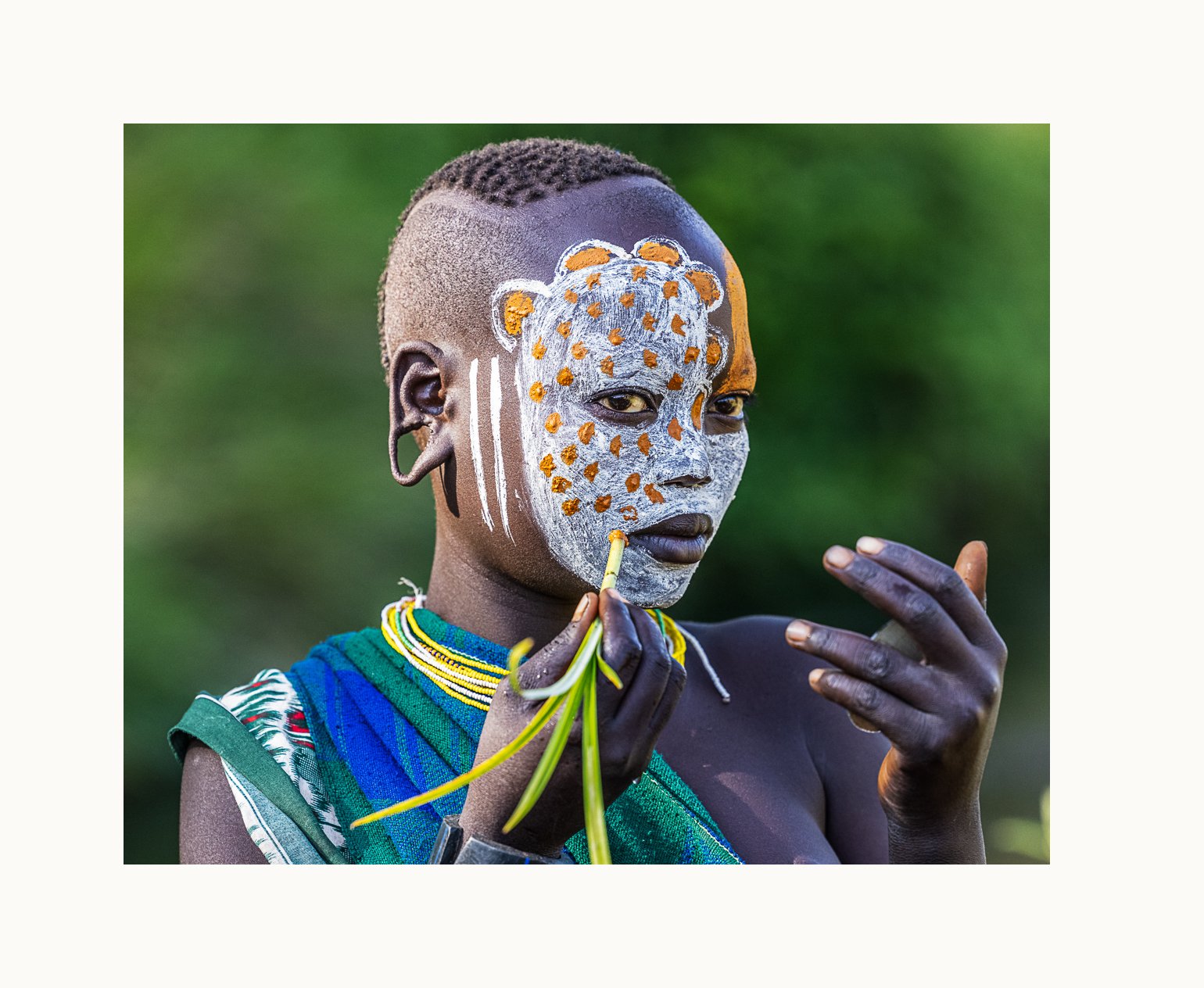
During a session at the river, Ngaguyɔ is applying face paint. Each color of Suri body paint is made from a specific type of rock or clay, crushed and mixed with water.
Ngaguyɔ’s “brush” for this part of her design is the stem of a plant. She’s also using a small mirror in her left hand for guidance. Kibish, Ethiopia, 2021.

guyɔ = rain. It was raining when Ngaguyɔ was born.
Lower elevation Suri lands are semi-arid, so any rain that falls is highly valued. Severe droughts have resulted in substantial losses of life. Rain in Suri territory is seasonal, but unpredictable, especially in the semi-arid lowlands. Nevertheless, the landscape near a perennial river like the Kibish can be lush. Kibish, Ethiopia, 2021.
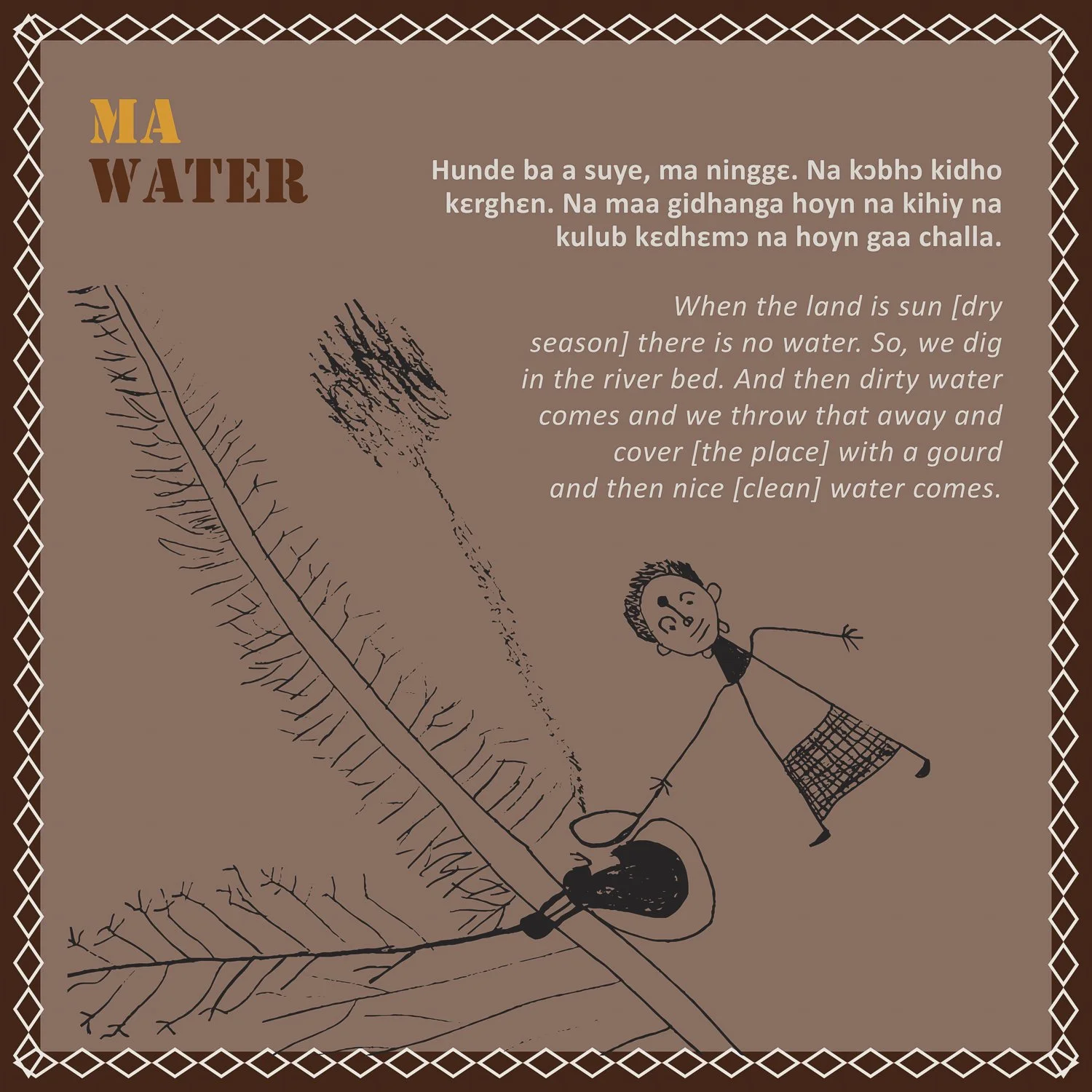
Even when a river bed appears to be dry, there may be a way to get water.
Suri author/artist: Bargaw Olekibo

barari = powerful. When Ngabarari was born, there was much drinking of strong local beer going on.
I previously defined “barari” as “spiritually powerful” (perhaps because my main definition advisor was a Bible translator!). Given Ngabarari’s actual name story, I’ve dropped the “spiritual” in this case.
Ngabarari went to school, but did not attend classes in Suri, though she believes they’re a good thing. Kibish, Ethiopia, 2021.
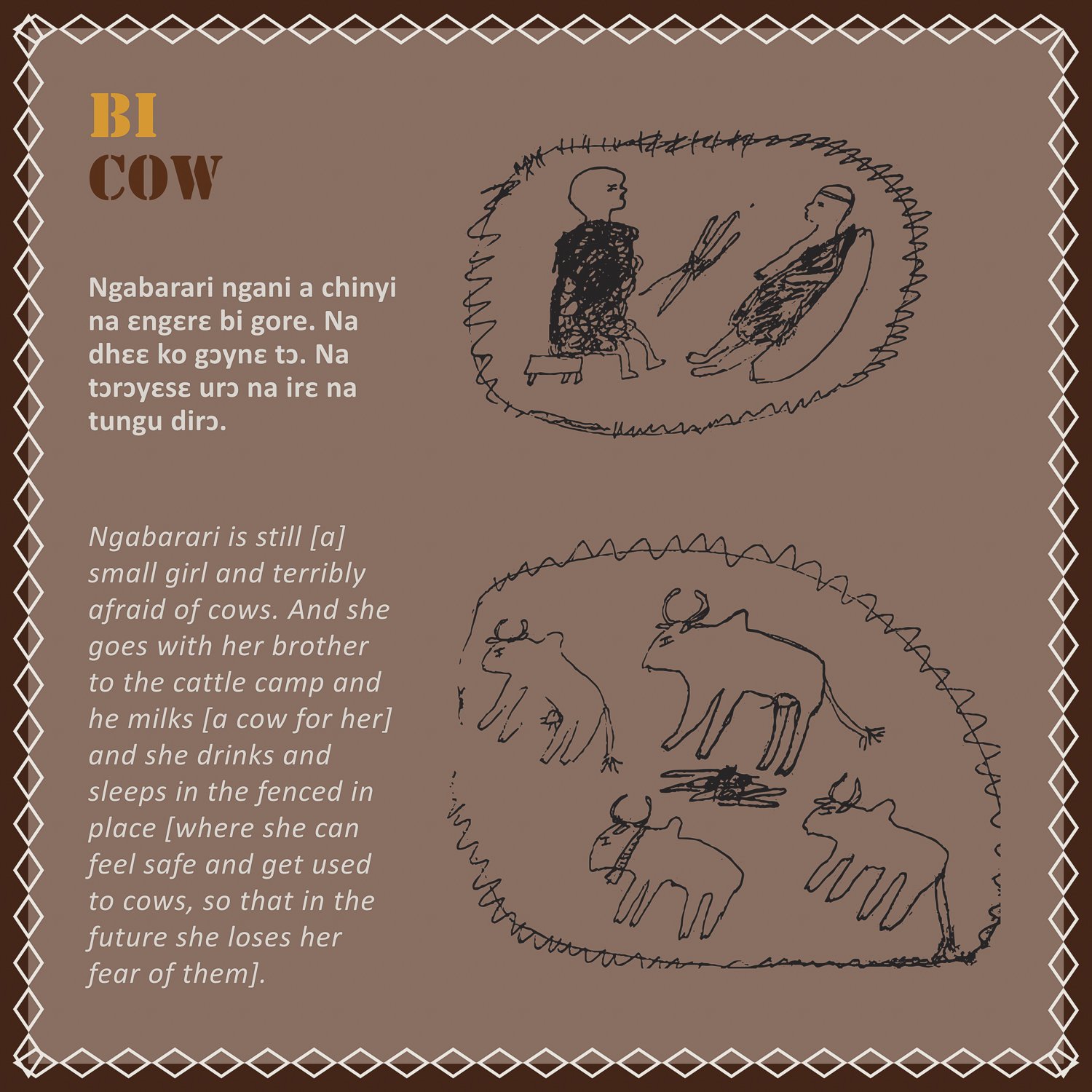
This word story centers around a young girl named Ngabarari and how her brother sought to make her more comfortable in the presence of cows.
Suri author/artist: Bargoy Dhɔgani

guyɔ = rain. It was rainy when Ngaguyɔ B was born.
Various traditional Suri activities typically happen after the seasonal rains, when food is usually more plentiful. For instance, that’s often when discussions of potential marriage alliances begin.
Earlobe discs are a strong Suri tradition, sometimes decorated and frequently worn on an everyday basis. These discs are losing some popularity among young Suri women, but not as much as lip plates. Kibish, Ethiopia, 2019.

The typical first step for Suri face painting is a trim along the hairline with a razor blade. Ngakɔshi’s friend Ngadidi is doing that trim.
Ngakɔshi’s son was born after my 2019 visit and therefore during the pandemic. His name is Barcorona (!). Kibish, Ethiopia, 2021.
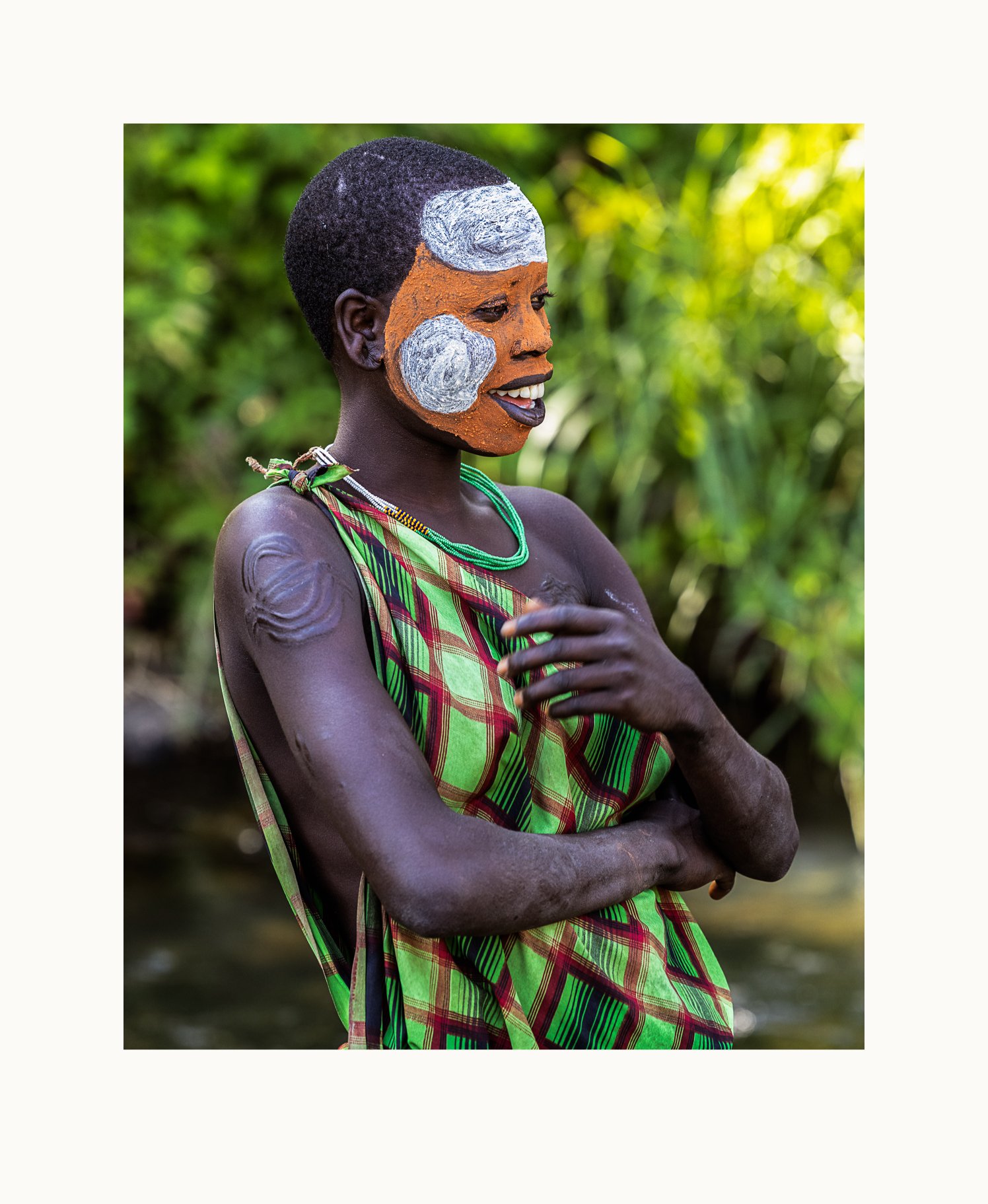
kɔshi = forest. Around the time of her birth, Ngakɔshi’s father was clearing forest for a new field; her mother took him food and that’s when Ngakɔshi was born.
Suri territory is mostly savannah, with foothills and some hills. Some areas in the higher elevations are forested. Kibish, Ethiopia, 2021.
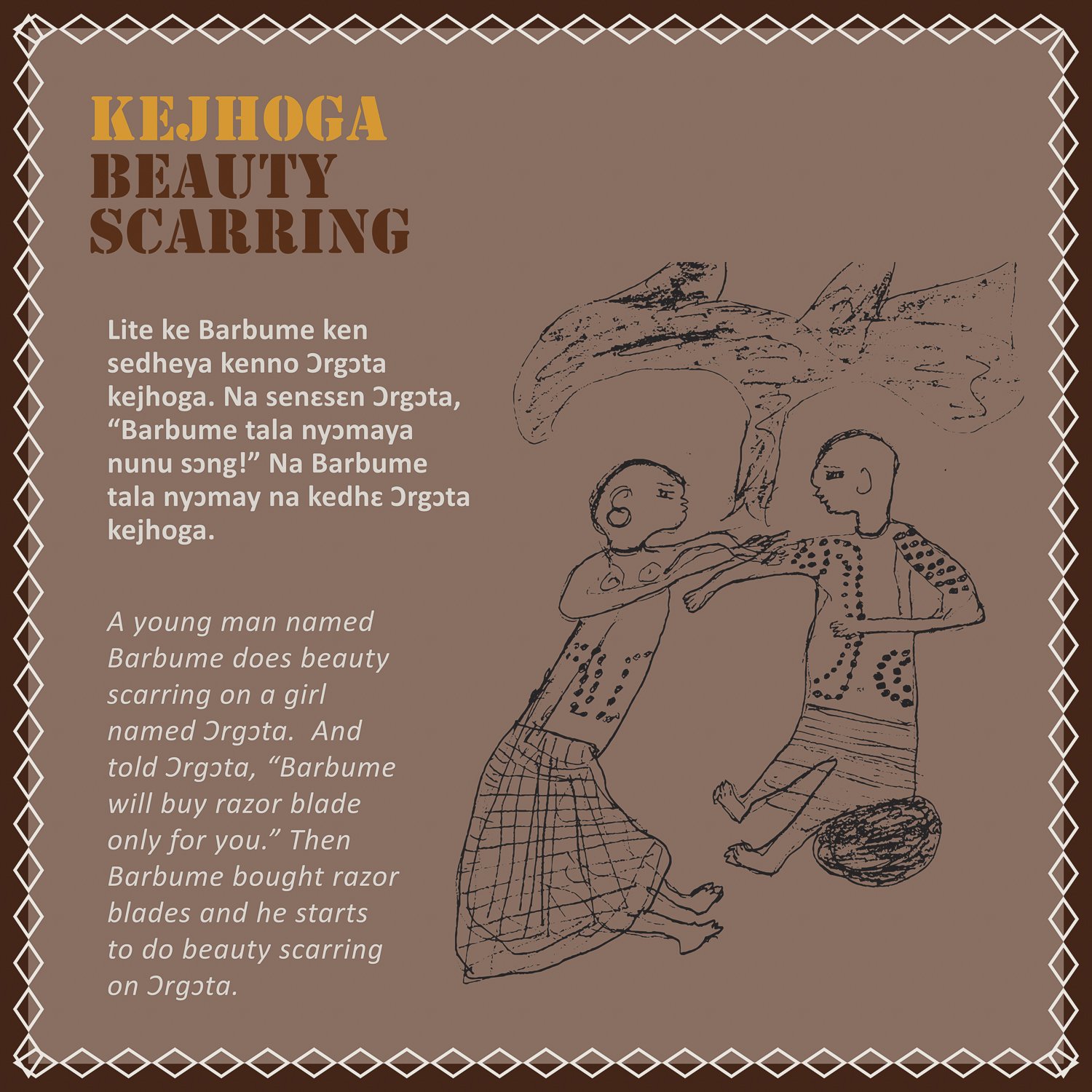
Many Suri create scars on their bodies to enhance their beauty and attract partners. During our 2021 visit, Ngakɔshi had a beauty scar added to her left arm as well, in anticipation of the following day’s gathering for a ceremonial stick fight.
Suri author/artist: Barlɛng Konggulugu
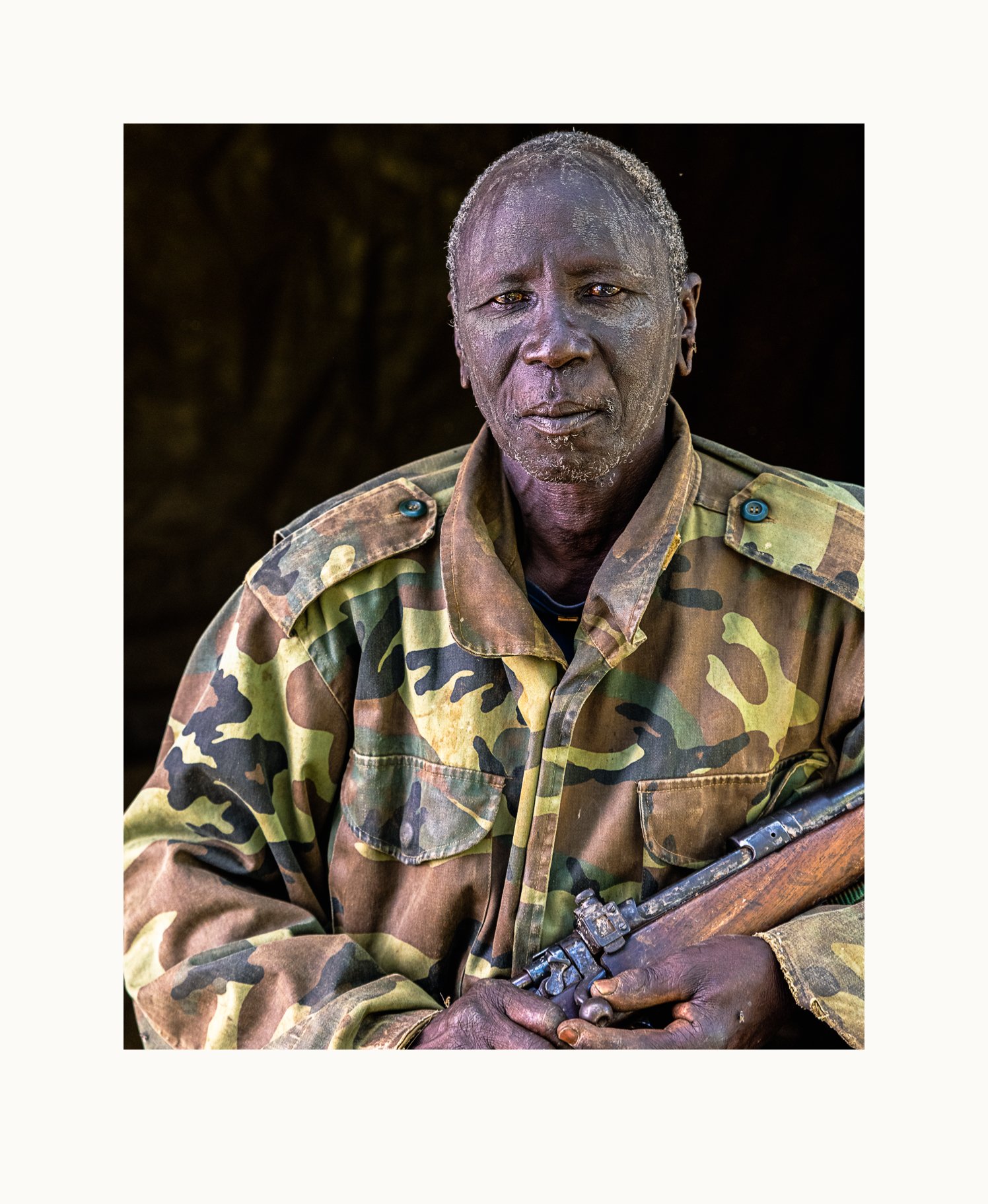
arsibhala = black bulls that have a white stripe. He was given that name in honor of a relative.
A respected Suri elder, Arsibhala is also among the richest local Suri in terms of cattle ownership (the traditional Suri measure of wealth).
Arsibhala strongly supports mother tongue education among the Suri. Kibish, Ethiopia, 2021.
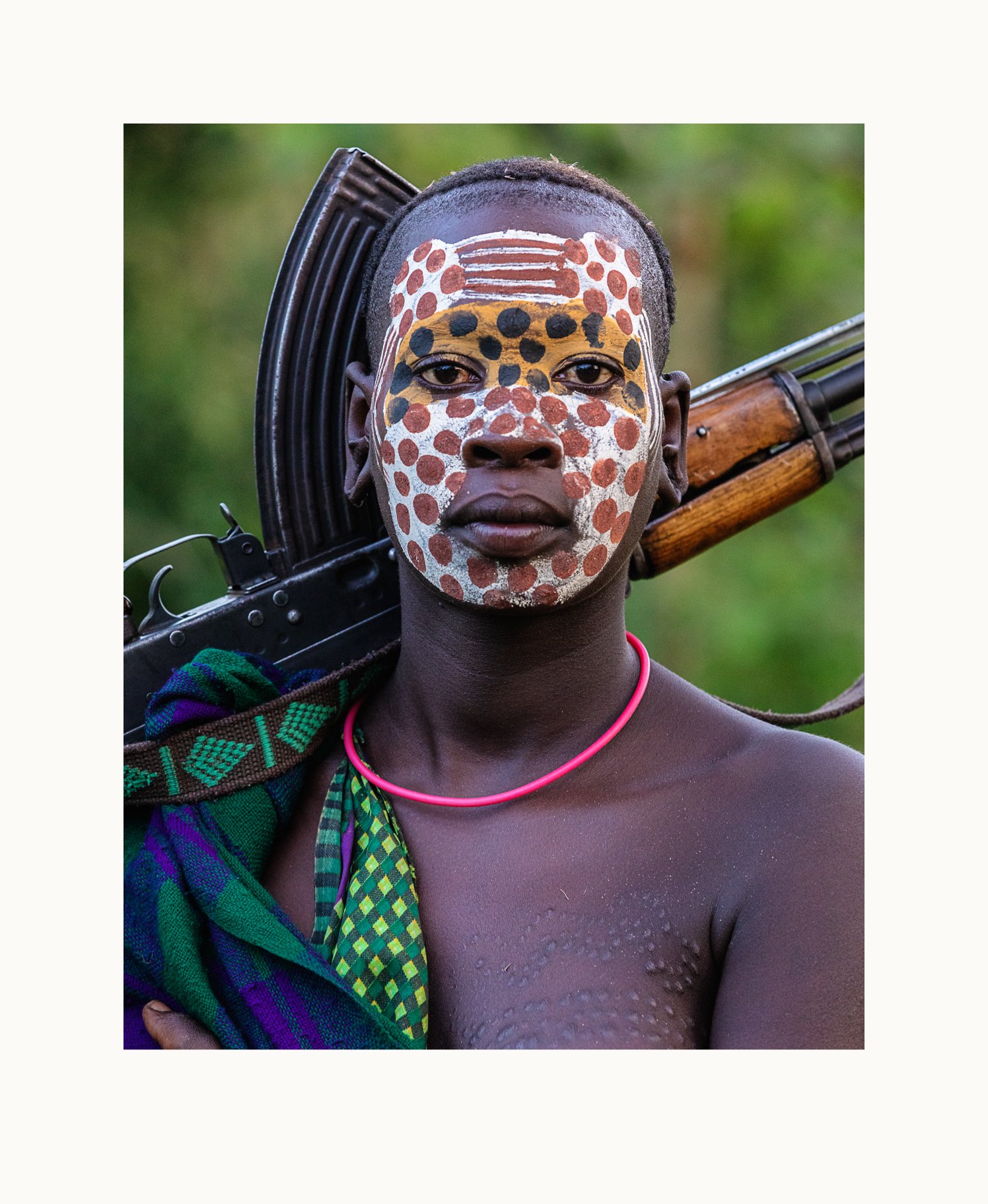
tutugi = path leading into and out of a family hut. Ngatutugi was born on that path outside her mother’s hut when her mother had gone out for other reasons. Arsibhala is her father.
The rifle she’s carrying belongs to her brother. She’s only fired it once: a traditional ten shots into the air to celebrate a new boyfriend. Kibish, Ethiopia, 2019.

luguru = second harvest; guru = deserted, as in a house or area.
These girlfriends are at a government-run village school, with a chalkboard in the background. Elsewhere on the chalkboard is a sketch of a lion, with a hand-written note in English: “This is a lion. It has four legs.” Kibish, Ethiopia, 2019.
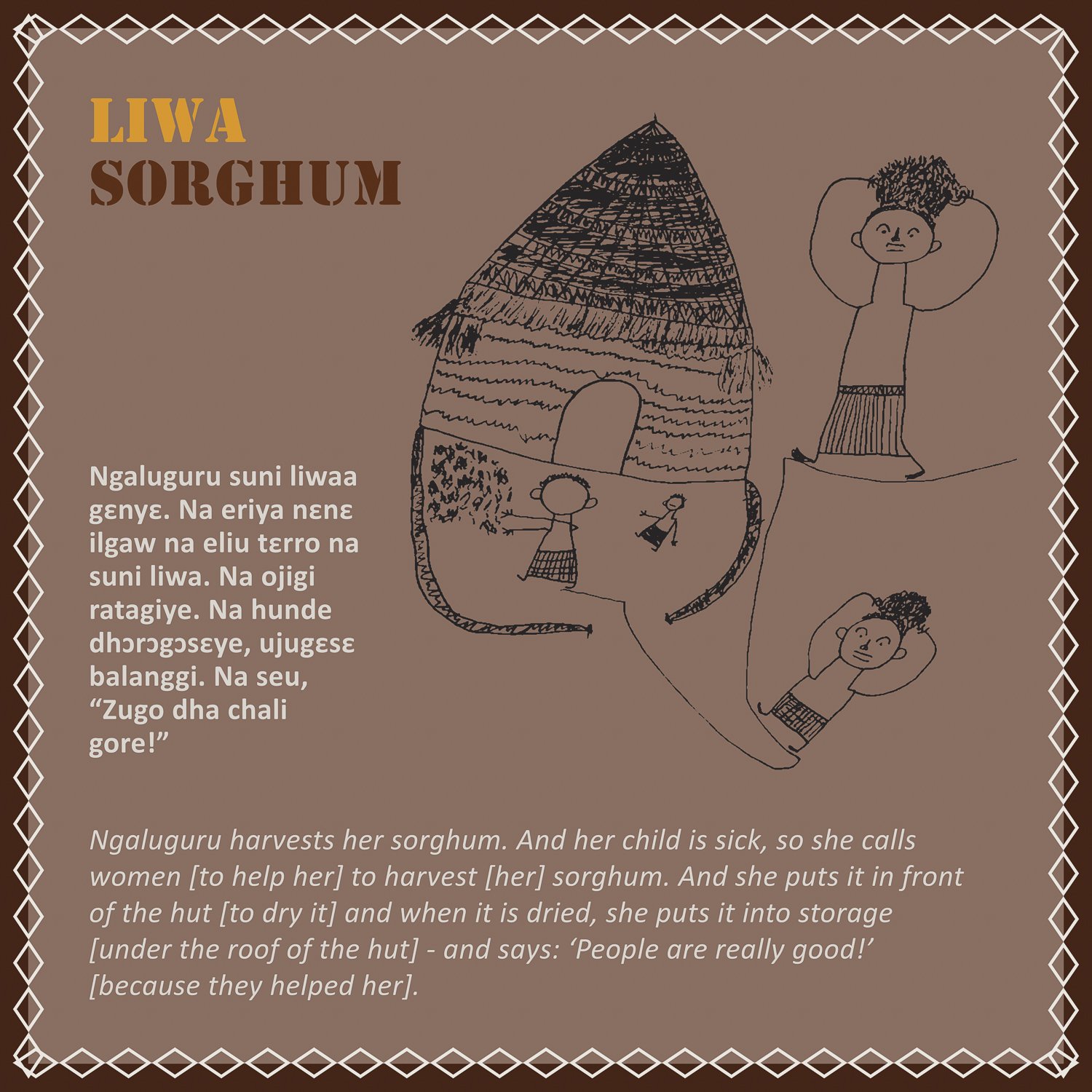
A woman named Ngaluguru appreciates the support of other women as she deals with challenges in harvesting her sorghum.
Suri author/artist: Bargaw Olekibo
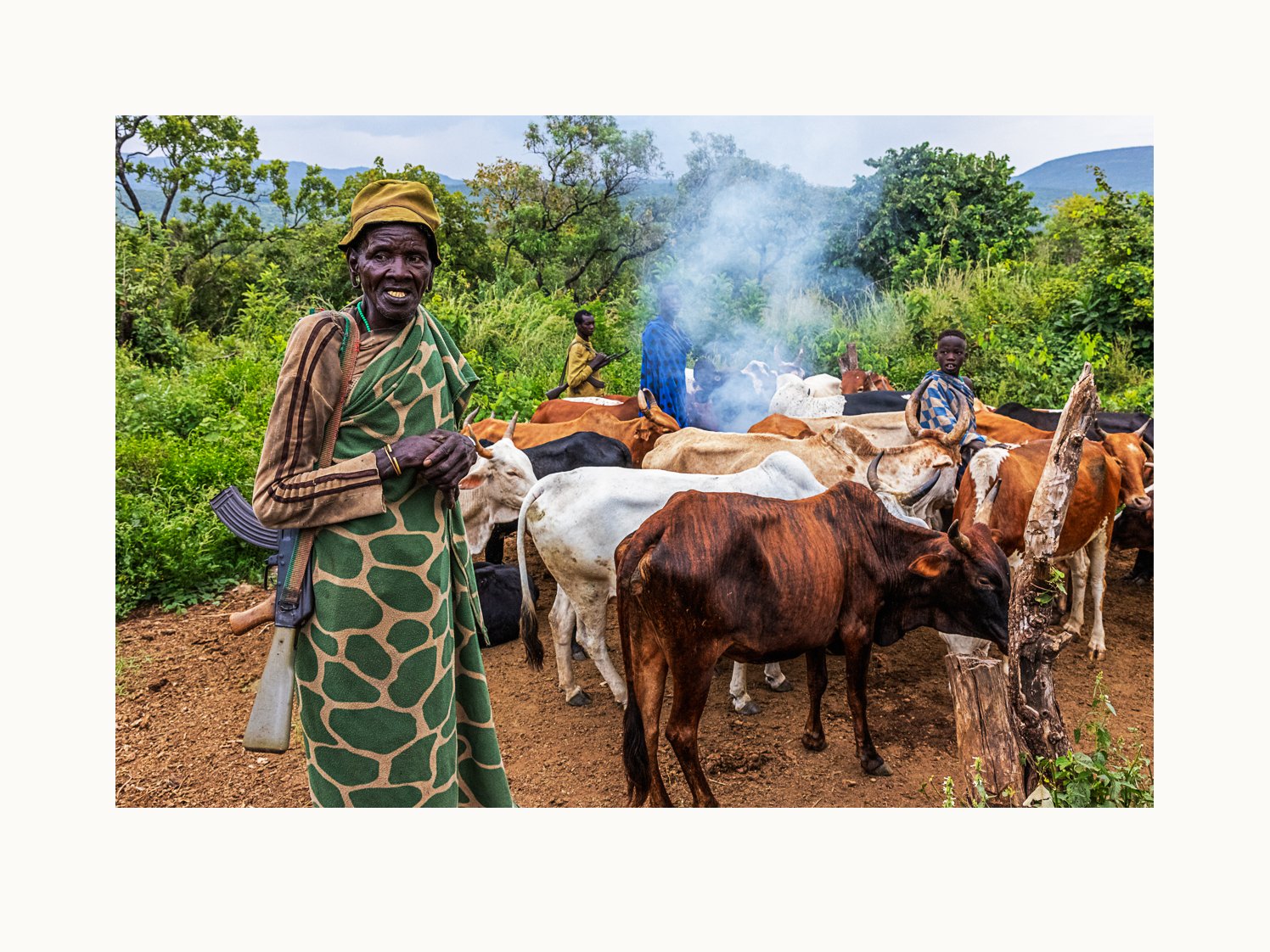
togonagasi = old goat. Togonagasi, in the foreground, got that name when he bought an old goat at a market one time and the name stuck.
This is one of his many cattle camps. A respected elder, he is among the wealthiest of the local Suri.
I never saw Togonagasi unarmed. Cattle raids (sometimes violent) are a constant threat – often by neighboring ethnic groups such as the one called Bume by the Suri.
Togonagasi believes that education in the Suri mother tongue is a big step forward and that it helps Suri students learn more effectively. Kibish, Ethiopia, 2021.
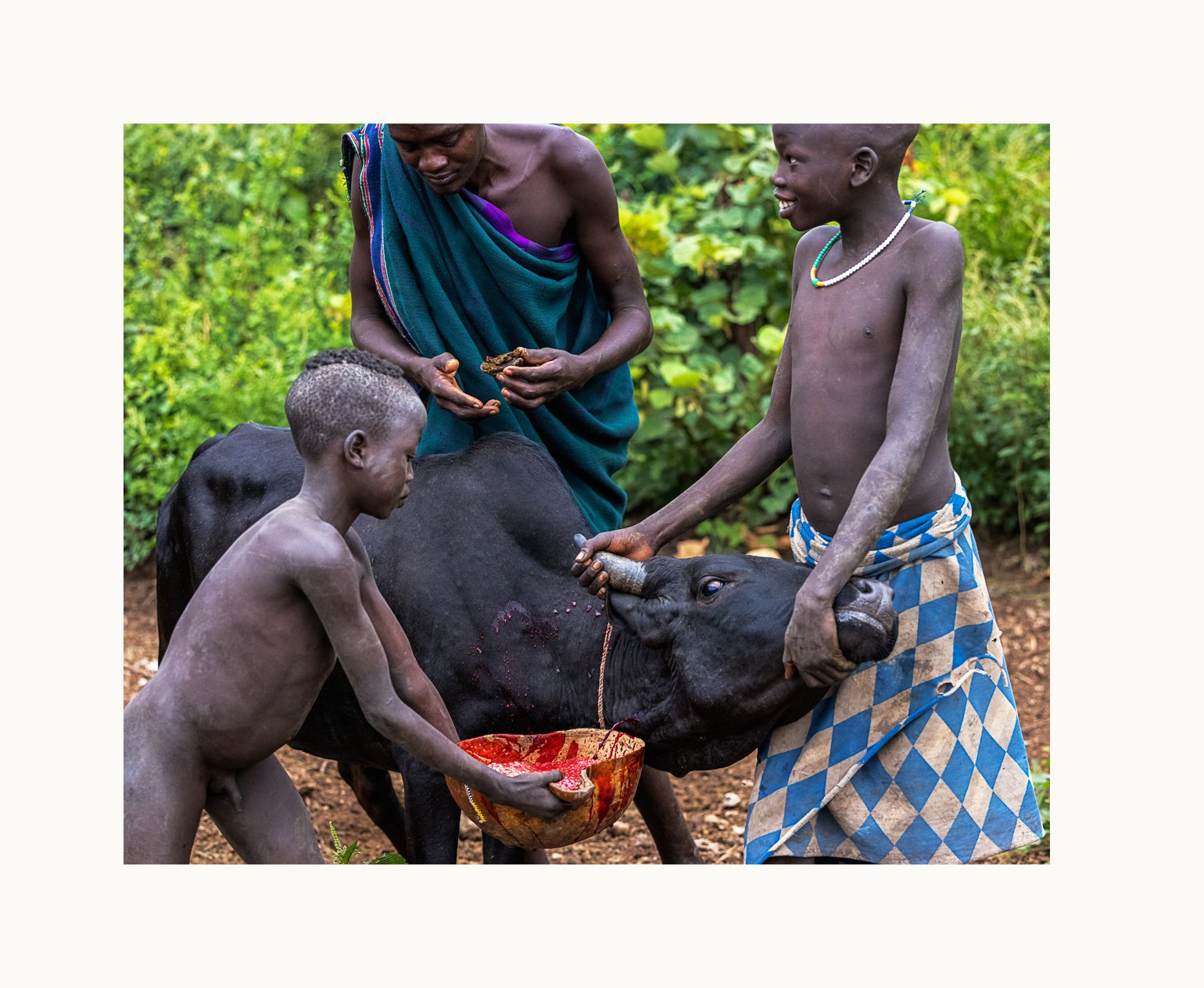
At remote Suri cattle camps, blood drawn from cattle can be an important source of protein.
Cattle camp boys are helping Barkonen (in the rear) with the process.
The blood draw starts with shooting a special arrow into a vein in a cow’s neck. The resulting stream of blood is collected in a gourd.
When sufficient blood has been drawn, Barkonen will cover the wound with the shaped poultice of cow dung that he is holding. Kibish, Ethiopia, 2021.













































This collection presents the Suri, a small but resilient group in southwestern Ethiopia. You’ll meet my portrait collaborators, including Ngaturɛ, who painted her face using local natural pigments, continuing a long Suri tradition. The collection also includes word stories created by Suri members of the project that produced the first Suri literacy teaching tools, starting in the early 2000s when the written language was defined. These word stories provide fascinating glimpses of Suri culture. The drawing here is from one of those word stories.
The small Kibish River is a critical water source for nearby Suri. On the right bank at this point is a massive stone pier for a future bridge over the river. So far, there is no corresponding pier on the left bank and no comparably sized connecting road on either side of the river.
But this pier is a harbinger of coming development encroachment challenges for the Suri people in this area. Ngamɔri, the Suri youngster crouched on top of the pier, will likely experience those challenges in her lifetime. Kibish, Ethiopia, 2019.
mɔri = pipe. Ngamɔri was born when her mother went to fetch water at a break in the pipeline carrying water to her village.
Suri parents encourage their children, both boys and girls, to be independent and assertive. Parents don’t use physical punishments, like beatings, but instead emphasize verbal encouragements and reprimands. Kibish, Ethiopia, 2019.
One meaning of mɔri is hose. Some larger Suri villages with a nearby perennial water source, such as Kibish, have water delivered via pipeline, then distributed within the village for domestic and garden use.
Suri author/artist: Gergere Siralugu
The word mɔri can also refer to tubular musical instruments, such as the flutes and horns referenced in this word story.
Suri author/artists: Damini Gelu, Ngaidho Bebhala
kɛdhɛdhi = wood ant. Wood ants are tiny and Ngakɛdhɛdhi was a tiny baby.
In addition to face paint and decorated earlobe discs, Ngakɛdhɛdhi has adorned her head with the long-haired fur of a colobus monkey. Colobus monkey fur is a traditionally respected form of head dress for Suri. Kibish, Ethiopia, 2019.
Colobus monkeys are popular with the Suri; they’re easy to live with.
Suri author/artist: Barkoginɛ Olrɛghɛ
Baboons, on the other hand, are a hassle to live with; they’re always stealing.
Suri author/artists: Gergere Siralugu, Bargoy Dhɔgani, Barlɛng Konggulugu, Barlolu Olechagi
konen = related by marriage, brother-in-law, for example.
Barkonen also participated in the previous day’s saginɛ (ceremonial stick fight), using his prized dongga (wooden staff). Consistent with tradition, he painted his body with clay for the event.
He started doing saginɛ when he was 12 years old. For every saginɛ, he gives necklaces to his girlfriend. It is important that she wears them at the saginɛ to show that they’re still a couple.
Barkonen is not yet married; he’s still collecting the necessary cattle. The Suri bridewealth tradition requires that his family transfer several dozen cattle before a marriage can happen. Kibish, Ethiopia, 2021.
mugur = darkness; hallo = hello on the phone.
Suri young people who paint their bodies sometimes choose matched patterns to celebrate a friendship. Each Suri boy receives a favorite young bull and he is responsible for its care. He is often addressed by the name of the bull and invokes that name in battles and on ritual occasions. Kibish, Ethiopia, 2019.
Suri boys often have cattle-related responsibilities, as illustrated in this word story.
Suri author/artist: Gergere Siralugu
turɛ = a special category of horn, including that used in the kilonga, a ceremony honoring a family-chosen anniversary of a passed elder. The kilonga ceremony is an important occasion at which family and friends in the passed elder’s community bring their favorite bulls and pay their respects. Ngaturɛ was born during a kilonga ceremony.
The role that cattle play in the consequential kilonga ceremony is further confirmation of how integral cattle are to Suri life. By tradition, Suri babies born during a kilonga are often named Ngaturɛ (for girls) or Barturɛ (for boys). Kibish, Ethiopia, 2021.
turɛ = a special category of horn that includes a type used in the kilonga ceremony that honors a family-chosen anniversary of a passed elder. Family and friends in the passed elder’s community bring their favorite bulls (usually adorned) and pay their respects.
Barturɛ was born during a kilonga ceremony. He is not married. He had a girlfriend, but her family asked for more cattle as bride-wealth than he could manage. Kibish, Ethiopia, 2021.
The owner of this steer has done elaborate adornments to demonstrate his affection. Most of the cattle brought to a kilonga ceremony would be extensively adorned, as well.
Suri author/artist: Barlolu Olechagi
lulɛ = a coordinated pattern, such as stripes on a zebra.
Ngalulɛ is a guest at a Suri wedding. For the Suri, a marriage is a multi-faceted alliance between the families of the bride and groom, culminating a lengthy negotiation between the two families, initiated by the prospective bride. The new bride will occupy her own hut, establish a separate domestic unit for herself and her children. A Suri husband spreads his time among the family units of his wives. Kibish, Ethiopia, 2019.
Ngalulɛ’s portrait was made at a Suri wedding. As usual for married Suri women attending a wedding, she wore her gal for the event.
Suri author/artist: Gergere Siralugu
Barhallo, already painted, is preparing to add paint to the face of Barsu, standing in the shallow Kibish River to his right.
Pigments are brought to the river as soft rock or clay: a specific type for each desired color. At the river, pigment material is crushed and mixed with water, then applied. Kibish, Ethiopia, 2021.
sedhey = girl; there were many young girls in the village when Ngasedhey was born.
When asked her age in 2021, she jokingly replied “200 years!”. Like Ngalulɛ, another elder Suri woman, Nga-sedhey had comments on non-traditional aspects of some of the adornments in my 2019 portraits. She expressed particular concern about the woven wreath that Ngakɔshi was holding in front of her face.
During our 2023 visit to Kibish, we had a smaller version of the 2nd generation exhibit hung among some trees in our camp. One of the Suri visitors to the exhibit was a daughter of Ngasedhey, who conveyed the sad news that her mother had recently passed away. The daughter was strongly moved by her mother’s portrait. Kibish, Ethiopia, 2019.
Smoking pipes made locally from garden-grown gourds (often decorated) can be an enjoyable communal activity.
Suri author/artist: Barlɛng Konggulugu
burbur = helicopter.
Burbur’s dongga (wooden staff) is the crucial weapon in a saginɛ (ceremonial stickfight). Saginɛ is very important to him. He’s a good fighter and has over 50 saginɛ wounds.
A Suri young man’s dongga is a multi-purpose tool, useful in cattle herding, for instance, but also as a personal statement, for example to impress a girlfriend.
Like many saginɛ participants, Burbur painted his body with clay for the prior day’s event. Kibish, Ethiopia, 2021.
baku = open air. Suri spend most of their waking hours in open air.
Ngabaku participated in courses taught in Suri and found them helpful, “because they were taught in my own language.” Also, there were incentives to take Suri classes, such as pen and pencil, exercise books; those were valuable, also.
When asked how she feels about being Suri; Ngabaku said: “Being Suri is happiness and delight!” Kibish, Ethiopia, 2019.
Mountain fig trees provide numerous benefits to the Suri, including those summarized in this illustrated story.
Suri author/artist: Bargoy Dhɔgani
For Suri men and boys, the painting tradition is a whole-body one.
A group of young men has just finished a body painting session at the Kibish River. They share their results in golden hour sunlight. Many of them would join the next day in a saginɛ (ceremonial stick fight), where most participants have painted bodies.
These Suri young men are in the tegay age set.
Body painting for Suri young men can be health- or hygiene-motivated, also. For instance, someone who is away from water in a remote camp and unable to bathe may cover his body with clay and then rub it off with a corn cob to clean. Kibish, Ethiopia, 2021.
Suri young men in the tegay age set have just completed a session of body painting at the Kibish River. They pause on the bank with the verdant landscape and distant mountains of Suri country in the background. Kibish, Ethiopia, 2021.
gu = garden. Ngagu was born in the garden behind her family hut.
Suri women maintain small gardens next to their family hut, where they grow vegetables, as well as gourds for use as containers.
Ngagu has taken courses in Suri and believes they helped her to learn more effectively. Kibish, Ethiopia, 2019.
Here we learn some vegetable recipe preferences of a woman named Ngakonɛn.
Suri author/artist: Gergere Siralugu
dukuwa = umbrella. However, in Ngadukuwa’s case, the important meaning of the word is a cattle color: a particular shade of white.
Ngadukuwa received her name when she got married, to honor both her and her husband. Dukuwa is both the name and the color of her husband’s favorite bull.
She wears her lip plate for special occasions like weddings and when serving her husband food and drink, because it shows respect. However, she has some regret that she adopted the lip plate tradition as a young girl, because the current generation doesn’t do lip plates. Kibish, Ethiopia, 2019.
biri = Ethiopian unit of currency, the birr.
In my 2021 exhibit and book, I identified Ngabiri as a man named Ngachurta, noting that it’s unusual for a man’s name to have the “Nga” prefix.
This mis-identification started when I didn’t get names for my Suri portrait collaborators as I was making the portraits in 2019. I had to scramble (during the pandemic in 2020!) to get their names long distance. Our lead Ethiopian guide helped by transferring thumbnail images to the local Suri guide, who showed them on his phone to ask for names. This awkward process mostly worked, but not always. Lesson: if you care about collaborator names (and you should!) learn them at portrait creation! Kibish, Ethiopia. 2019.
Ngaidho works informally with students in government school classroom. She taught for 10 years with the Suri Literacy Project (SLP), mostly with adult women students.
After almost two years of closed schools, teachers and students were enthusiastic about reconnecting in a classroom setting.
The SLP ended in mid-2021, leaving Ngaidho unemployed and her adult students with worries and questions about their and their families’ educational futures. Kibish, Ethiopia, 2021.
When we interviewed her, Ngaguyɔ (in the foreground, clearly an enthusiastic student) told us that she aims to become a doctor.
She also said that she enjoyed participating in Suri literacy classes. She found it helpful to learn in Suri because it is her mother tongue. Kibish, Ethiopia, 2021.
During a session at the river, Ngaguyɔ is applying face paint. Each color of Suri body paint is made from a specific type of rock or clay, crushed and mixed with water.
Ngaguyɔ’s “brush” for this part of her design is the stem of a plant. She’s also using a small mirror in her left hand for guidance. Kibish, Ethiopia, 2021.
guyɔ = rain. It was raining when Ngaguyɔ was born.
Lower elevation Suri lands are semi-arid, so any rain that falls is highly valued. Severe droughts have resulted in substantial losses of life. Rain in Suri territory is seasonal, but unpredictable, especially in the semi-arid lowlands. Nevertheless, the landscape near a perennial river like the Kibish can be lush. Kibish, Ethiopia, 2021.
Even when a river bed appears to be dry, there may be a way to get water.
Suri author/artist: Bargaw Olekibo
barari = powerful. When Ngabarari was born, there was much drinking of strong local beer going on.
I previously defined “barari” as “spiritually powerful” (perhaps because my main definition advisor was a Bible translator!). Given Ngabarari’s actual name story, I’ve dropped the “spiritual” in this case.
Ngabarari went to school, but did not attend classes in Suri, though she believes they’re a good thing. Kibish, Ethiopia, 2021.
This word story centers around a young girl named Ngabarari and how her brother sought to make her more comfortable in the presence of cows.
Suri author/artist: Bargoy Dhɔgani
guyɔ = rain. It was rainy when Ngaguyɔ B was born.
Various traditional Suri activities typically happen after the seasonal rains, when food is usually more plentiful. For instance, that’s often when discussions of potential marriage alliances begin.
Earlobe discs are a strong Suri tradition, sometimes decorated and frequently worn on an everyday basis. These discs are losing some popularity among young Suri women, but not as much as lip plates. Kibish, Ethiopia, 2019.
The typical first step for Suri face painting is a trim along the hairline with a razor blade. Ngakɔshi’s friend Ngadidi is doing that trim.
Ngakɔshi’s son was born after my 2019 visit and therefore during the pandemic. His name is Barcorona (!). Kibish, Ethiopia, 2021.
kɔshi = forest. Around the time of her birth, Ngakɔshi’s father was clearing forest for a new field; her mother took him food and that’s when Ngakɔshi was born.
Suri territory is mostly savannah, with foothills and some hills. Some areas in the higher elevations are forested. Kibish, Ethiopia, 2021.
Many Suri create scars on their bodies to enhance their beauty and attract partners. During our 2021 visit, Ngakɔshi had a beauty scar added to her left arm as well, in anticipation of the following day’s gathering for a ceremonial stick fight.
Suri author/artist: Barlɛng Konggulugu
arsibhala = black bulls that have a white stripe. He was given that name in honor of a relative.
A respected Suri elder, Arsibhala is also among the richest local Suri in terms of cattle ownership (the traditional Suri measure of wealth).
Arsibhala strongly supports mother tongue education among the Suri. Kibish, Ethiopia, 2021.
tutugi = path leading into and out of a family hut. Ngatutugi was born on that path outside her mother’s hut when her mother had gone out for other reasons. Arsibhala is her father.
The rifle she’s carrying belongs to her brother. She’s only fired it once: a traditional ten shots into the air to celebrate a new boyfriend. Kibish, Ethiopia, 2019.
luguru = second harvest; guru = deserted, as in a house or area.
These girlfriends are at a government-run village school, with a chalkboard in the background. Elsewhere on the chalkboard is a sketch of a lion, with a hand-written note in English: “This is a lion. It has four legs.” Kibish, Ethiopia, 2019.
A woman named Ngaluguru appreciates the support of other women as she deals with challenges in harvesting her sorghum.
Suri author/artist: Bargaw Olekibo
togonagasi = old goat. Togonagasi, in the foreground, got that name when he bought an old goat at a market one time and the name stuck.
This is one of his many cattle camps. A respected elder, he is among the wealthiest of the local Suri.
I never saw Togonagasi unarmed. Cattle raids (sometimes violent) are a constant threat – often by neighboring ethnic groups such as the one called Bume by the Suri.
Togonagasi believes that education in the Suri mother tongue is a big step forward and that it helps Suri students learn more effectively. Kibish, Ethiopia, 2021.
At remote Suri cattle camps, blood drawn from cattle can be an important source of protein.
Cattle camp boys are helping Barkonen (in the rear) with the process.
The blood draw starts with shooting a special arrow into a vein in a cow’s neck. The resulting stream of blood is collected in a gourd.
When sufficient blood has been drawn, Barkonen will cover the wound with the shaped poultice of cow dung that he is holding. Kibish, Ethiopia, 2021.